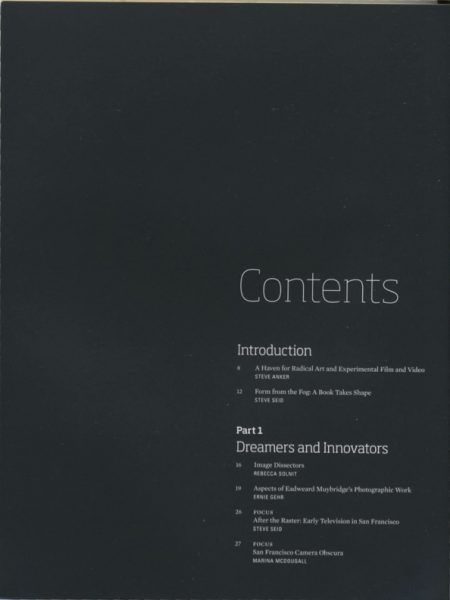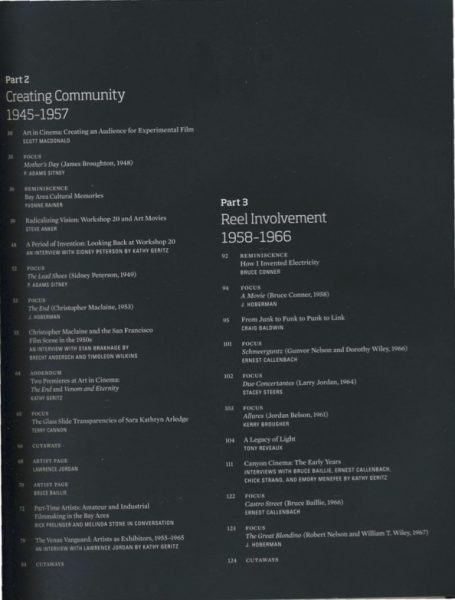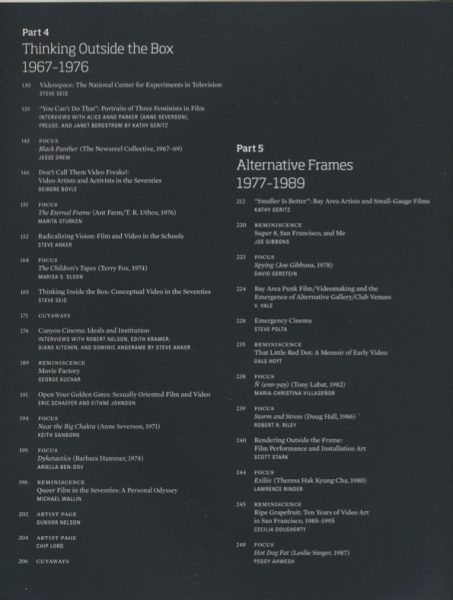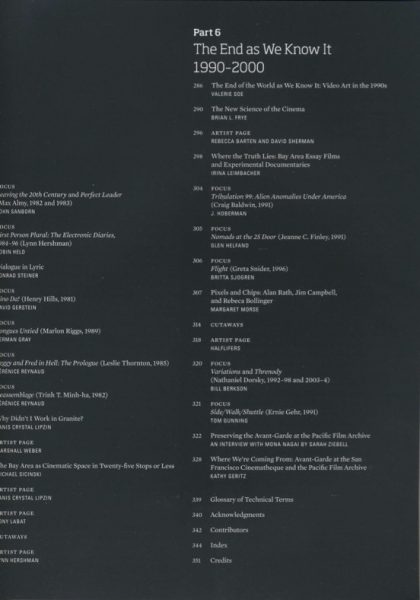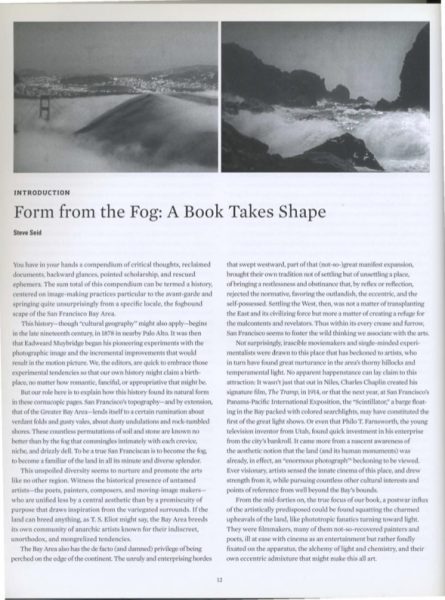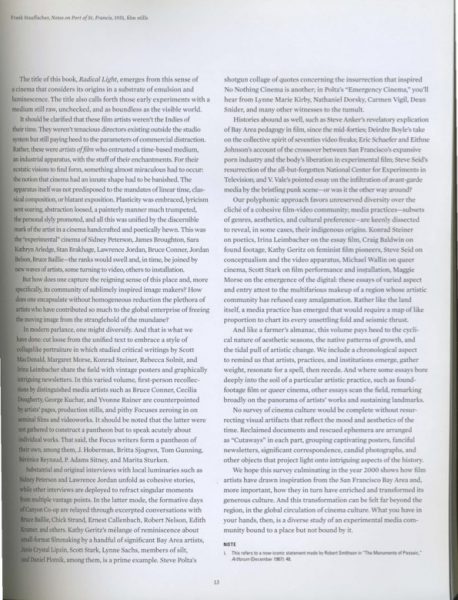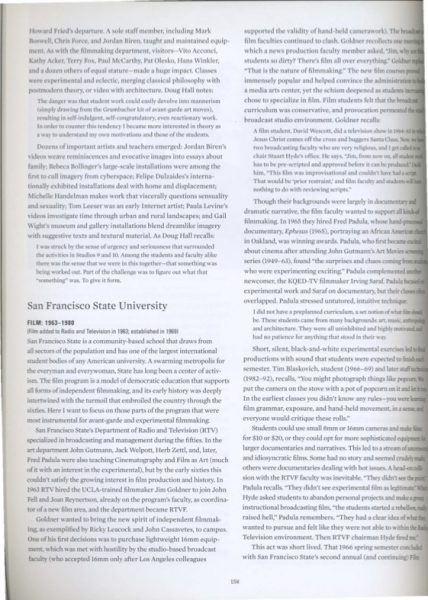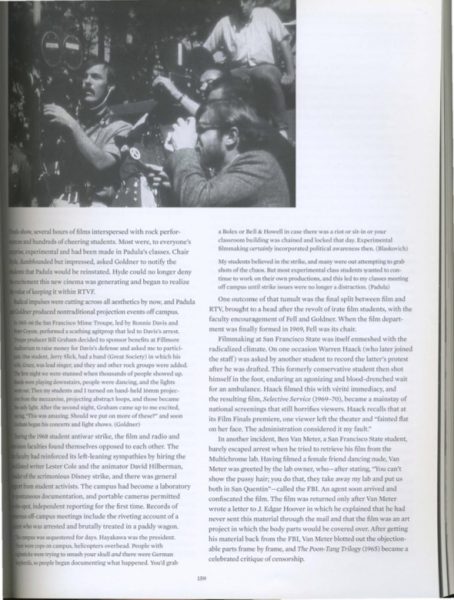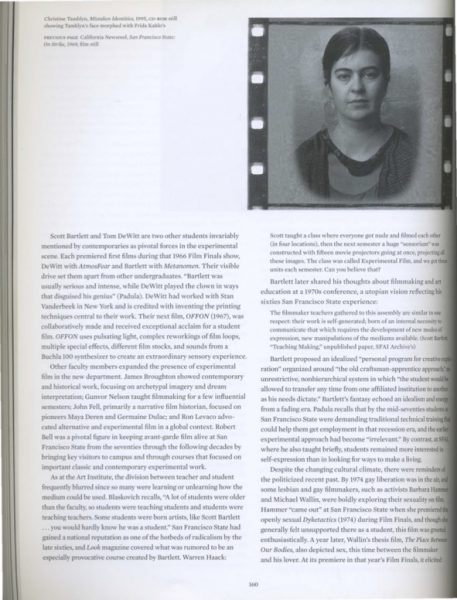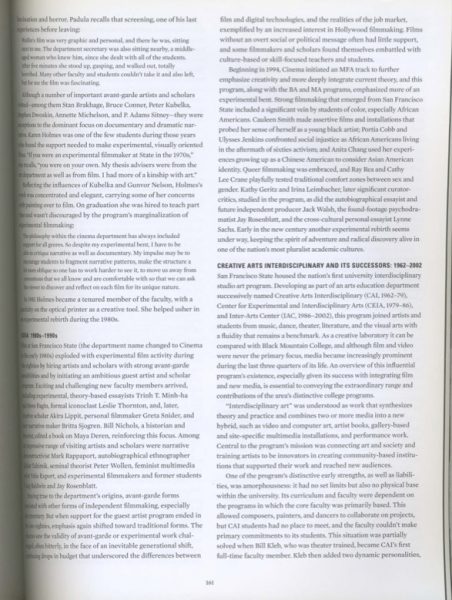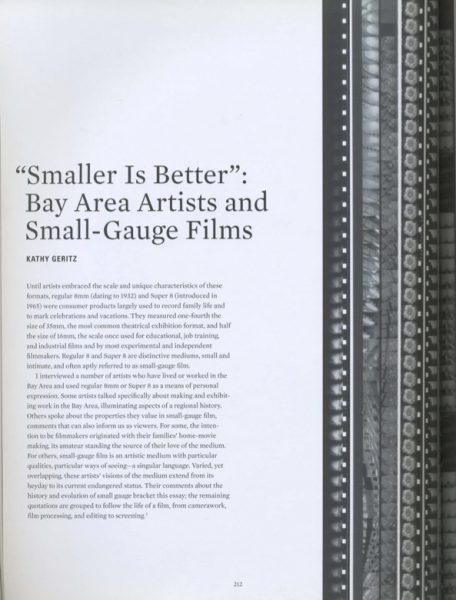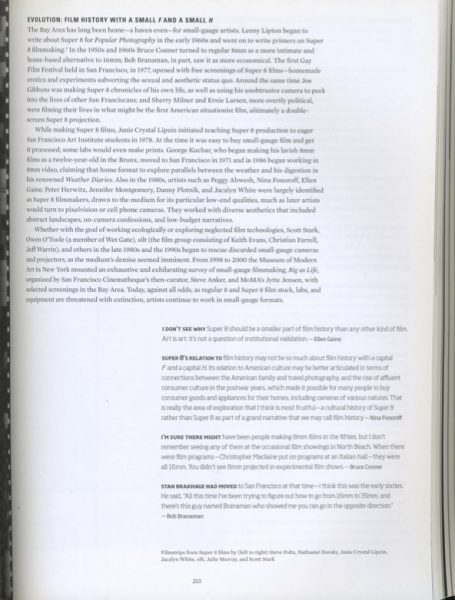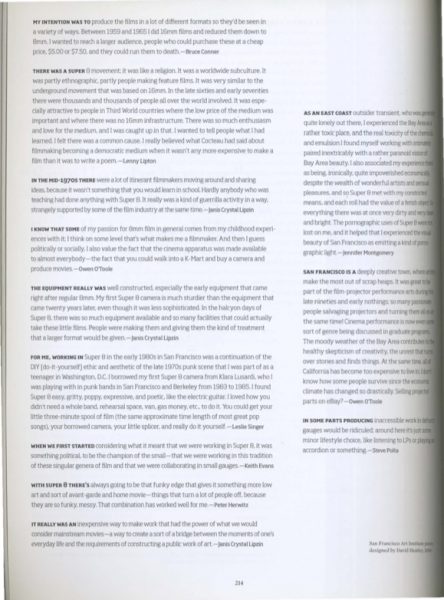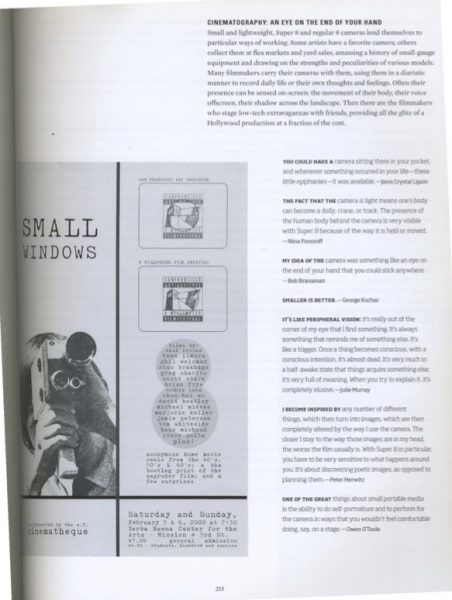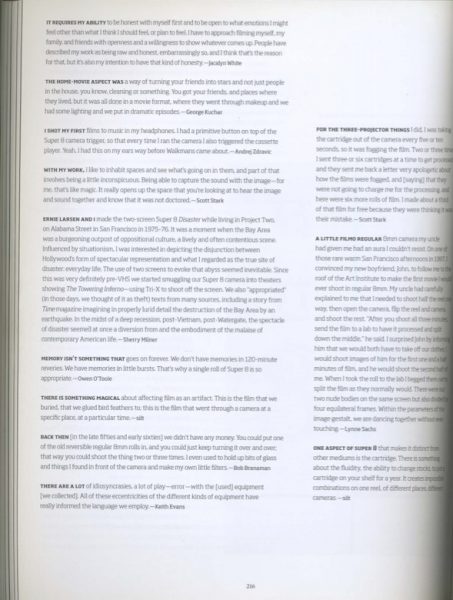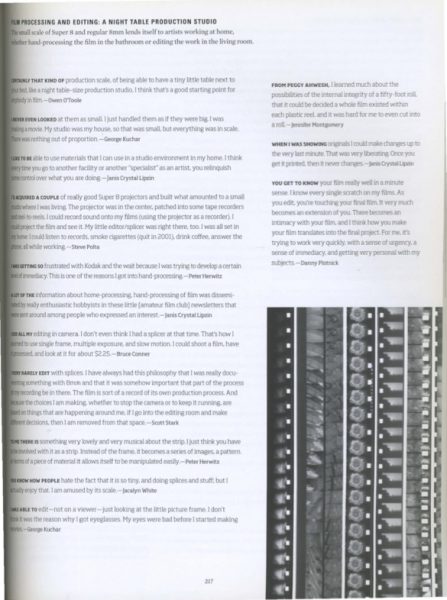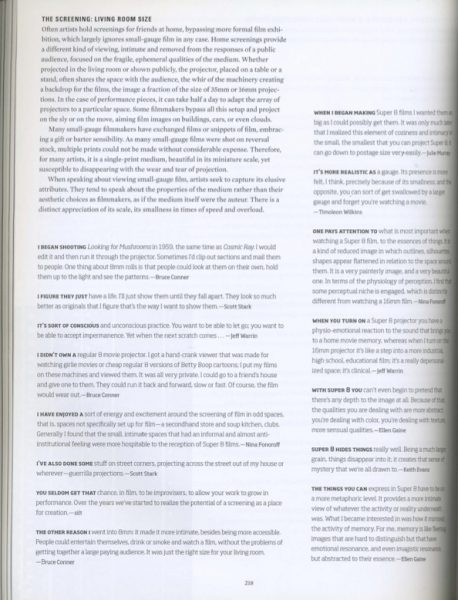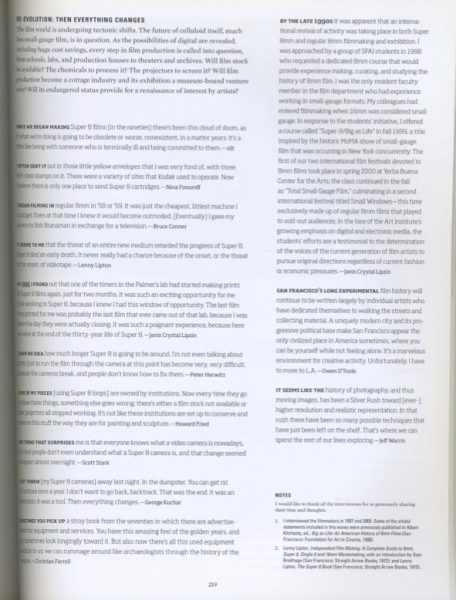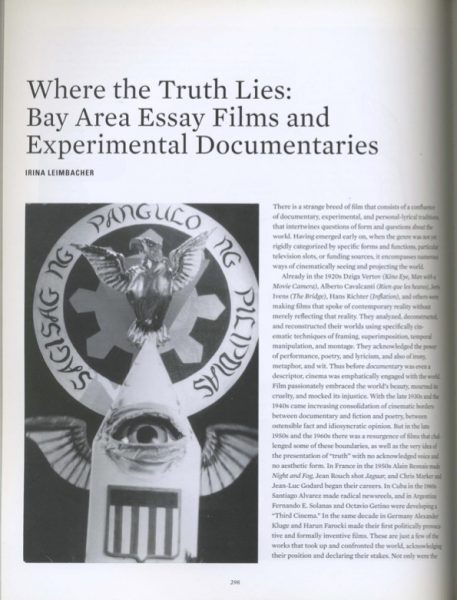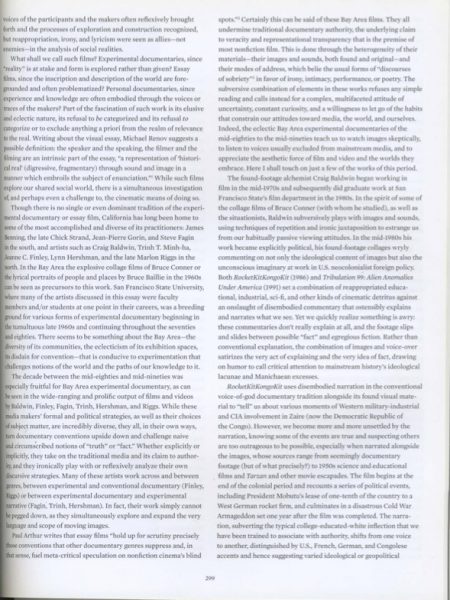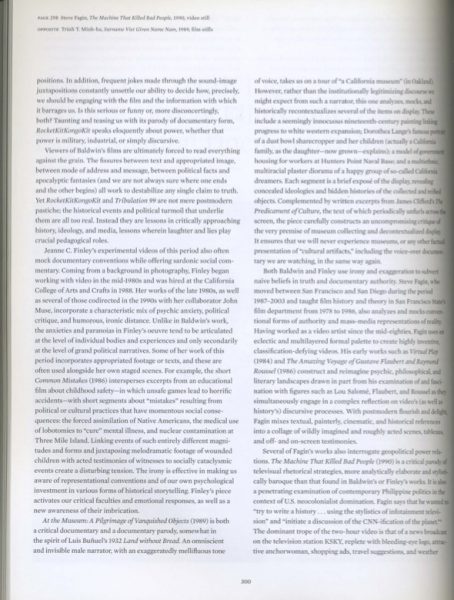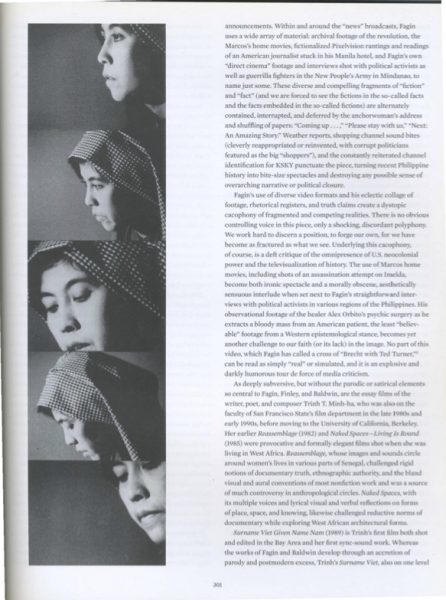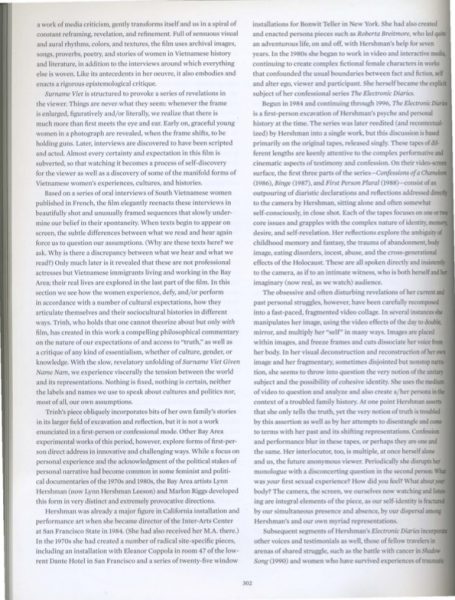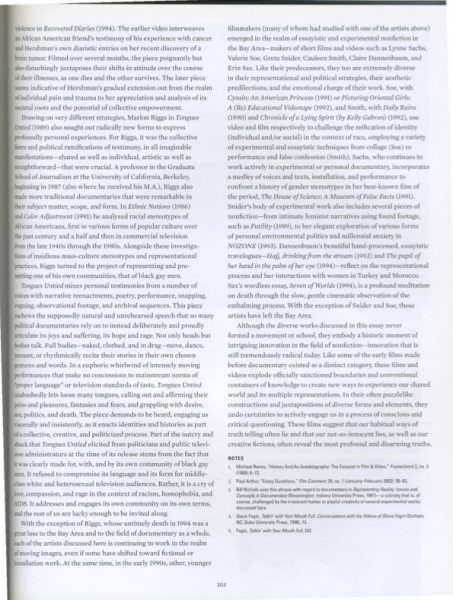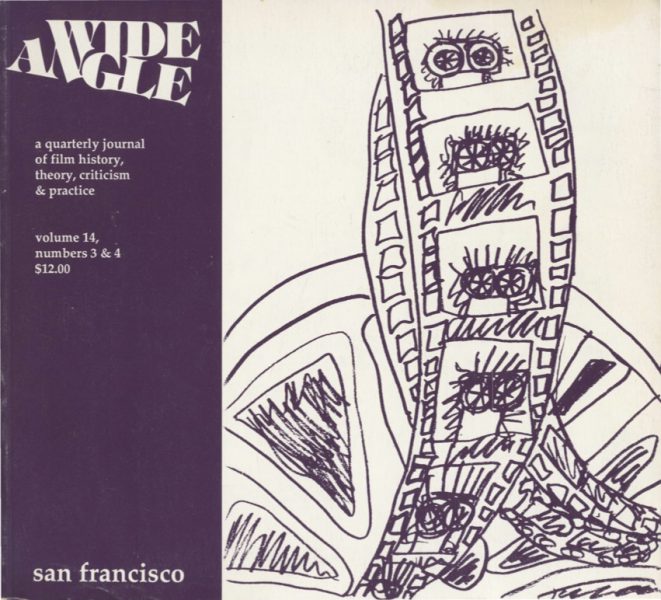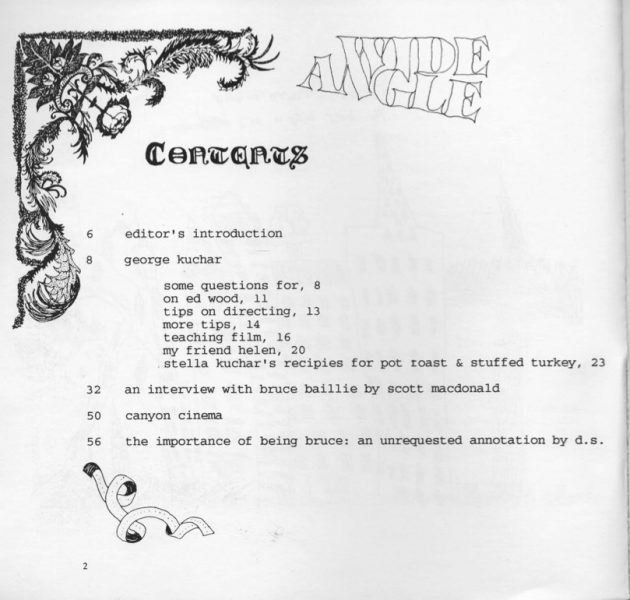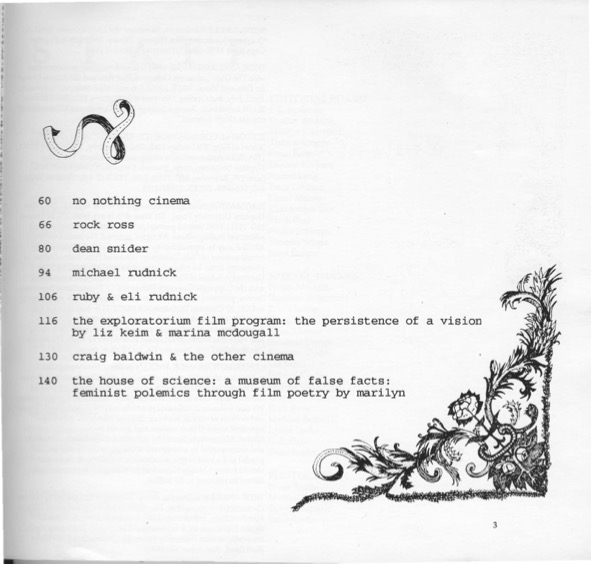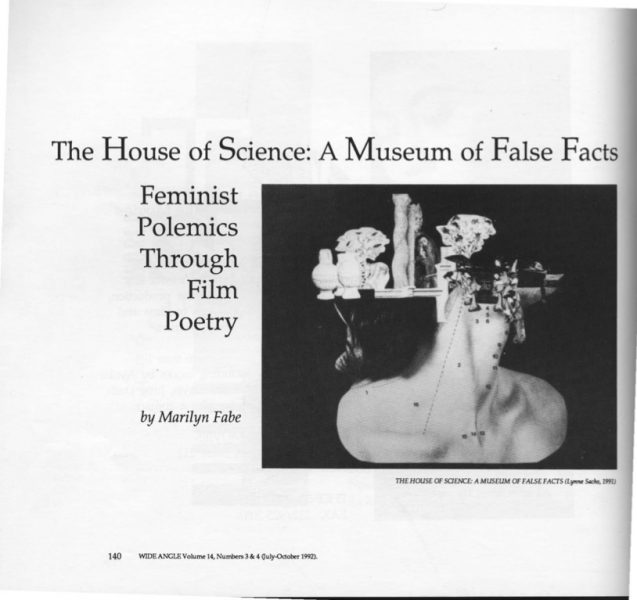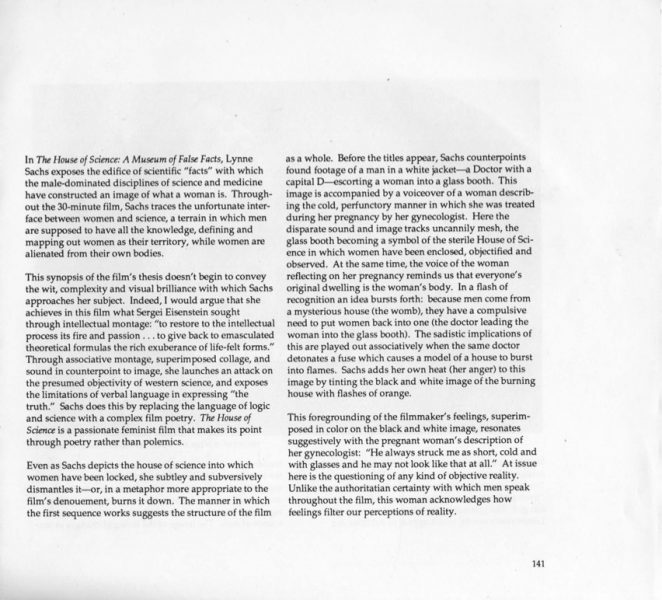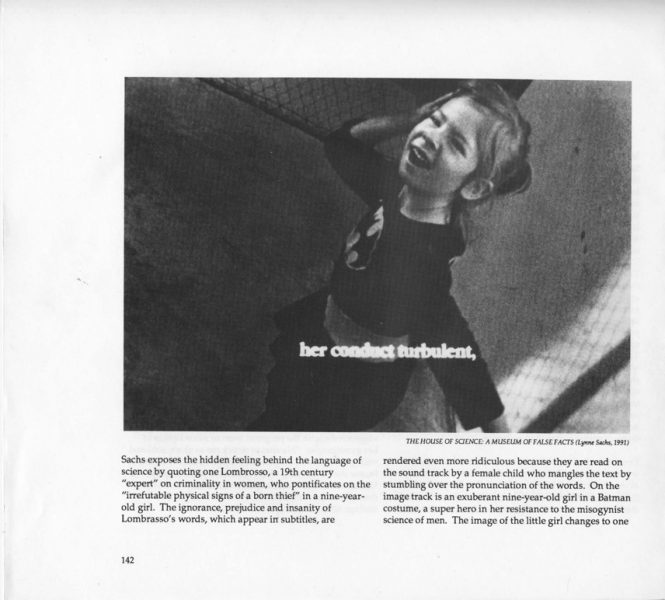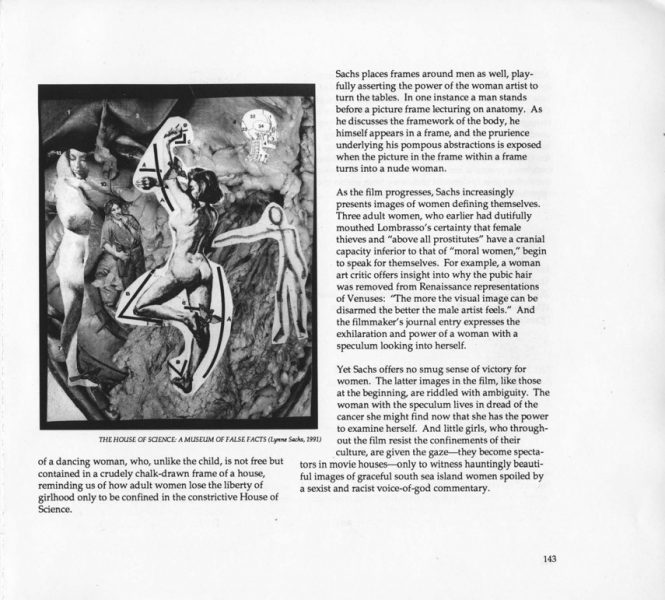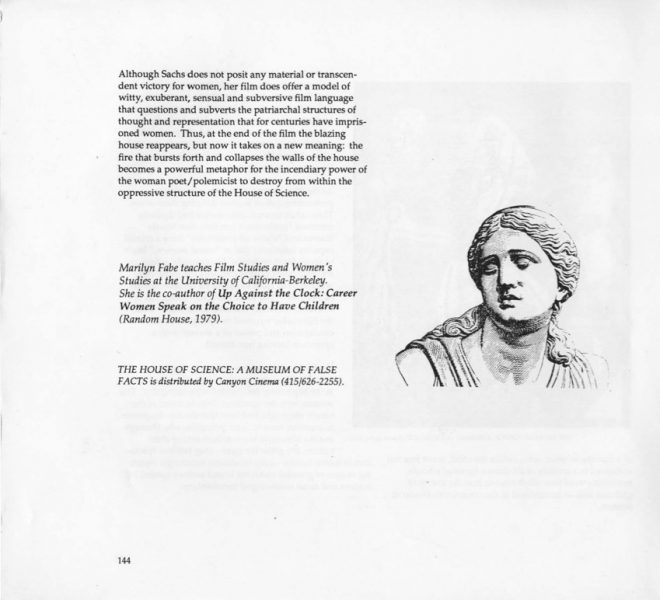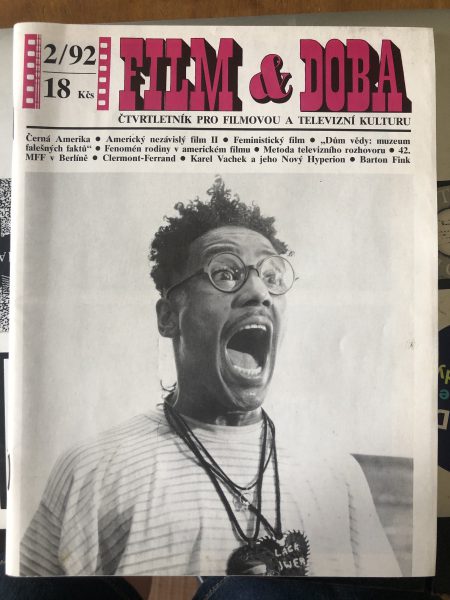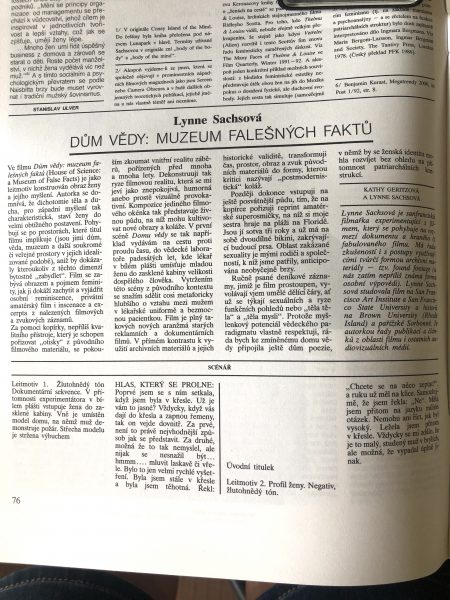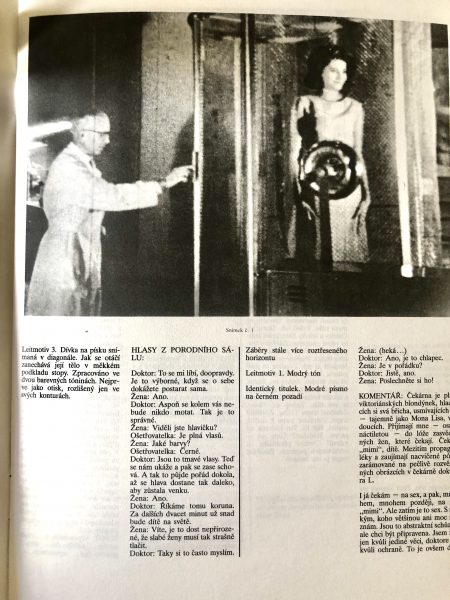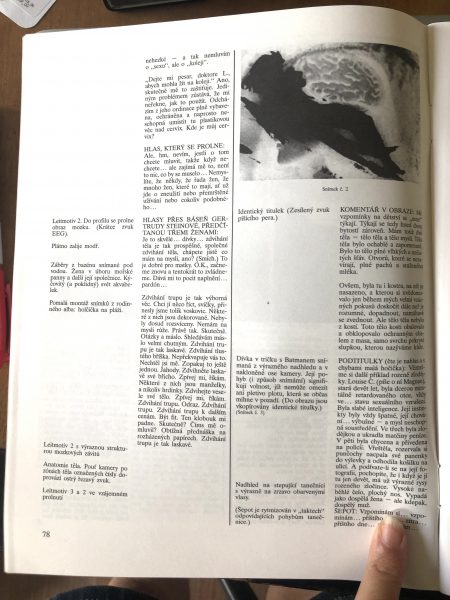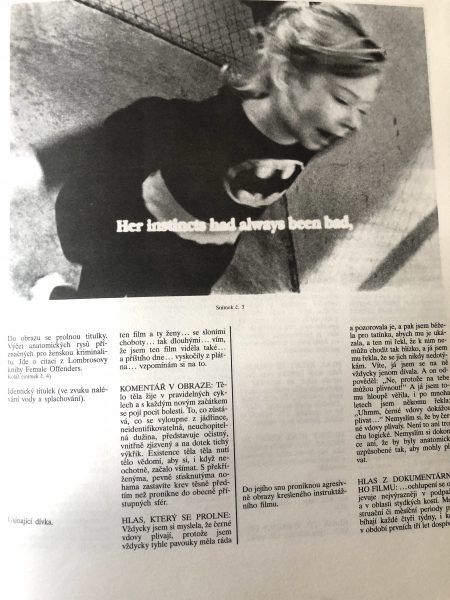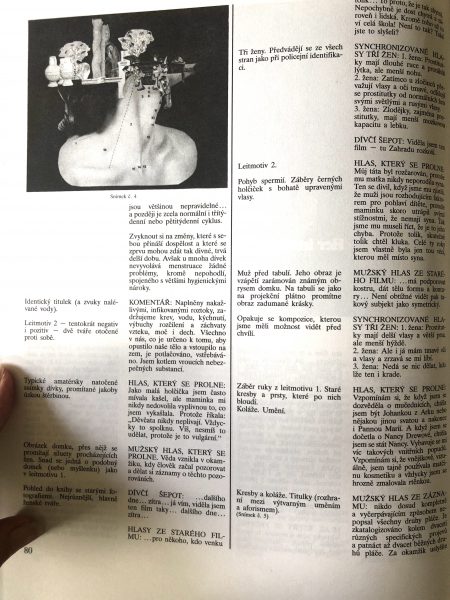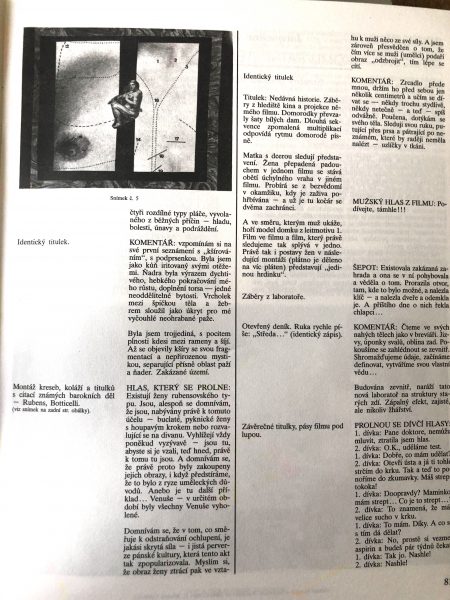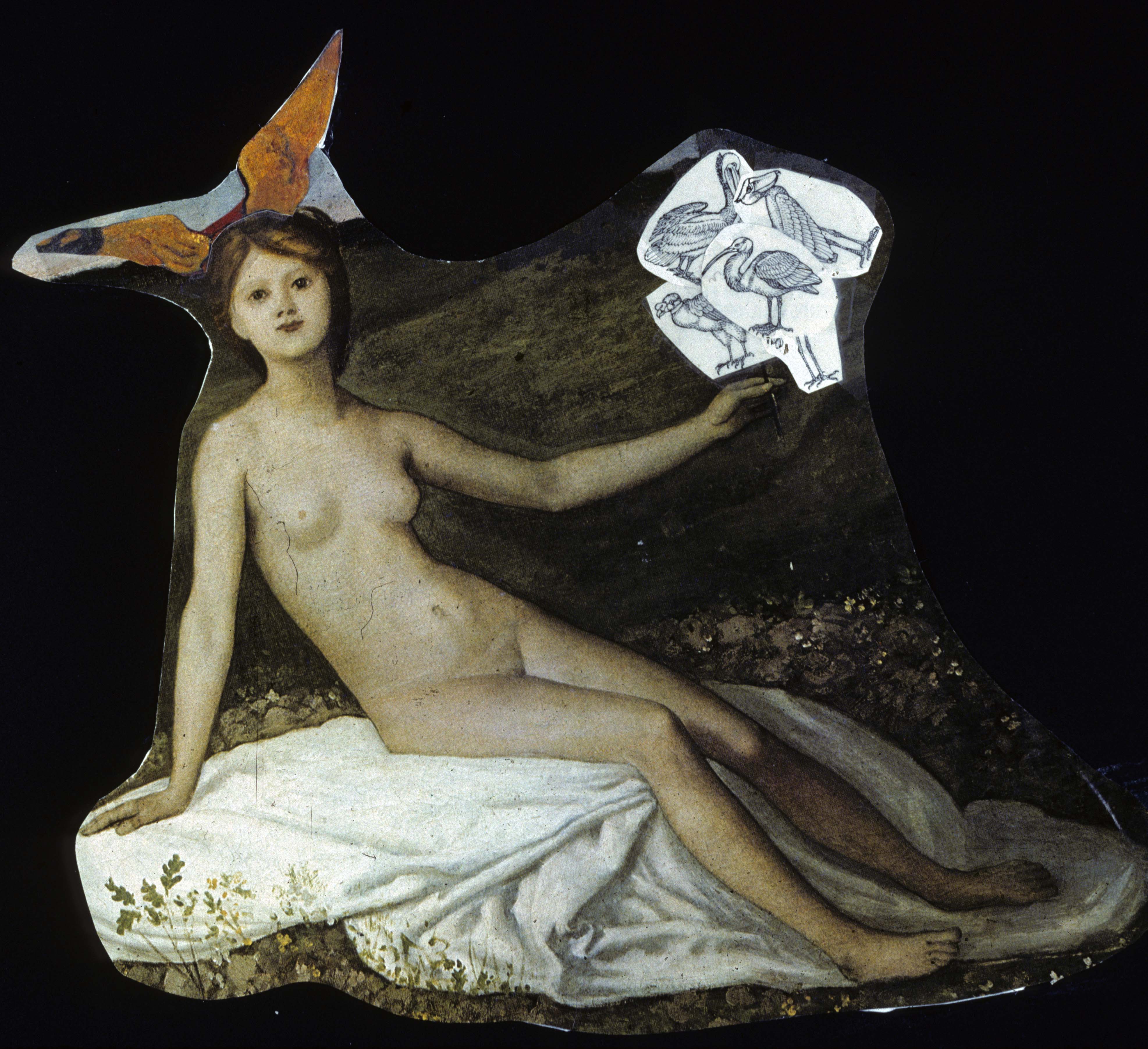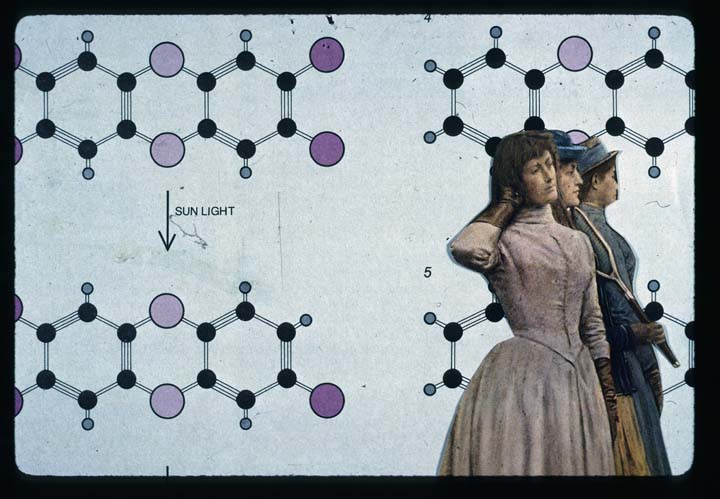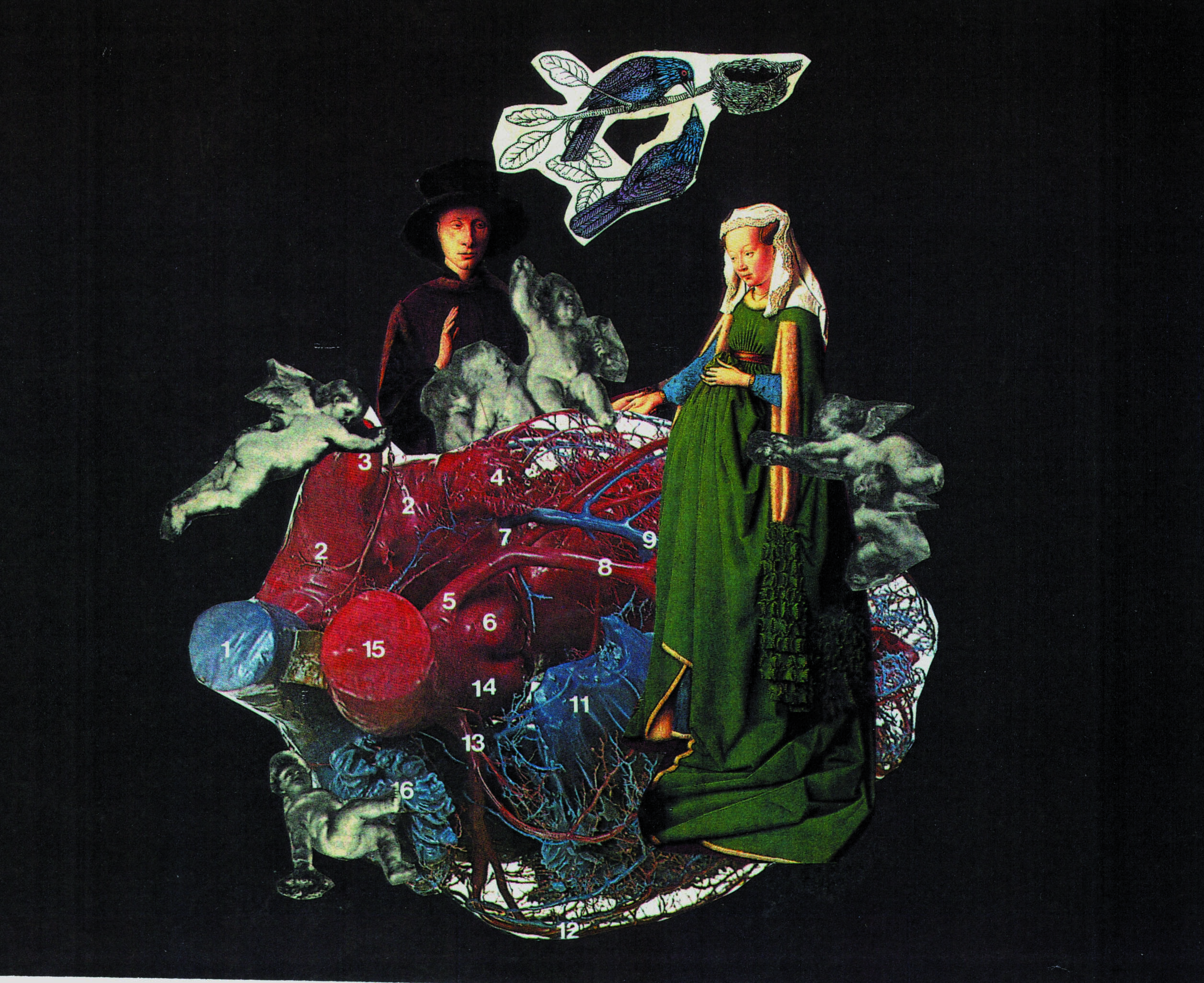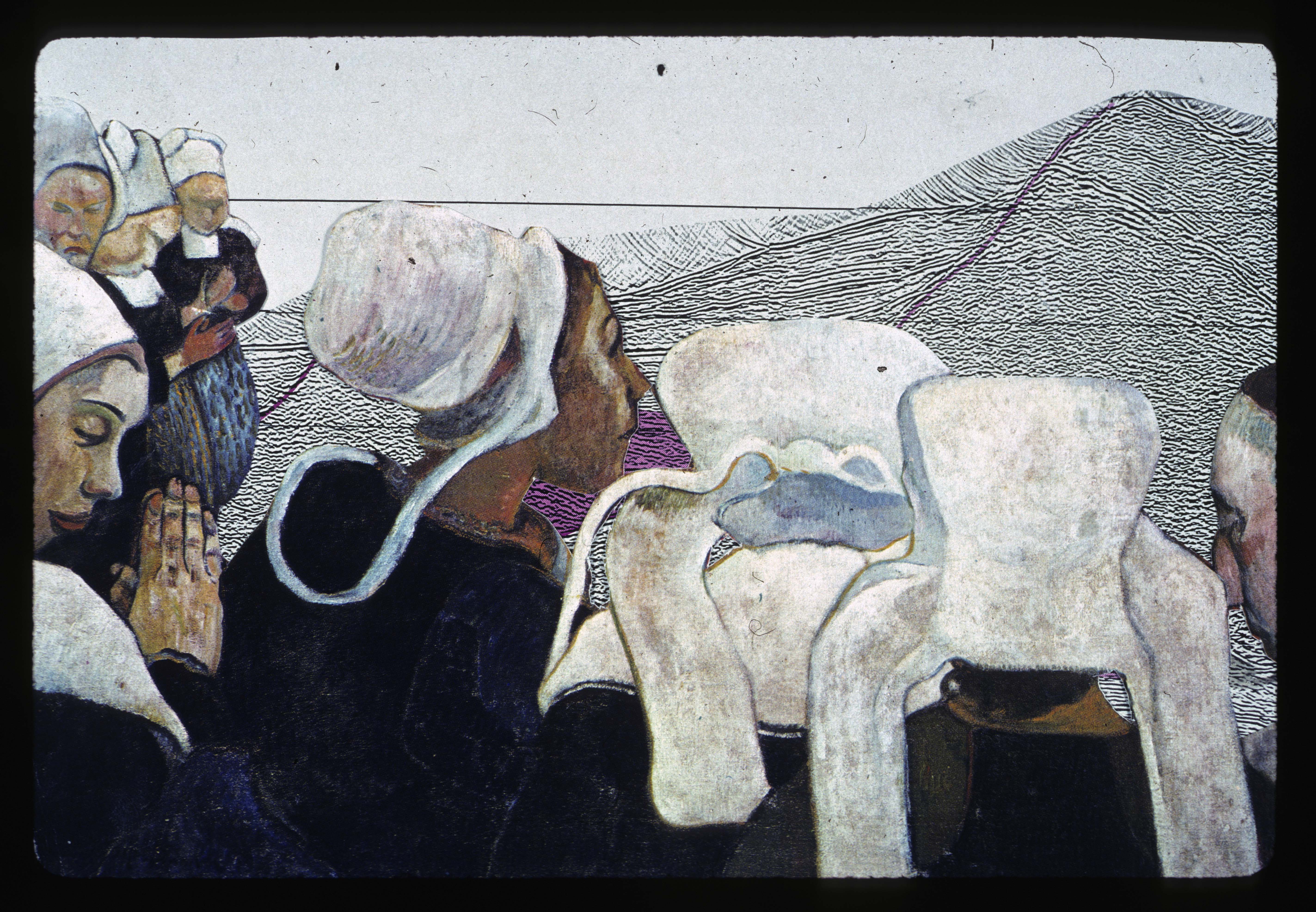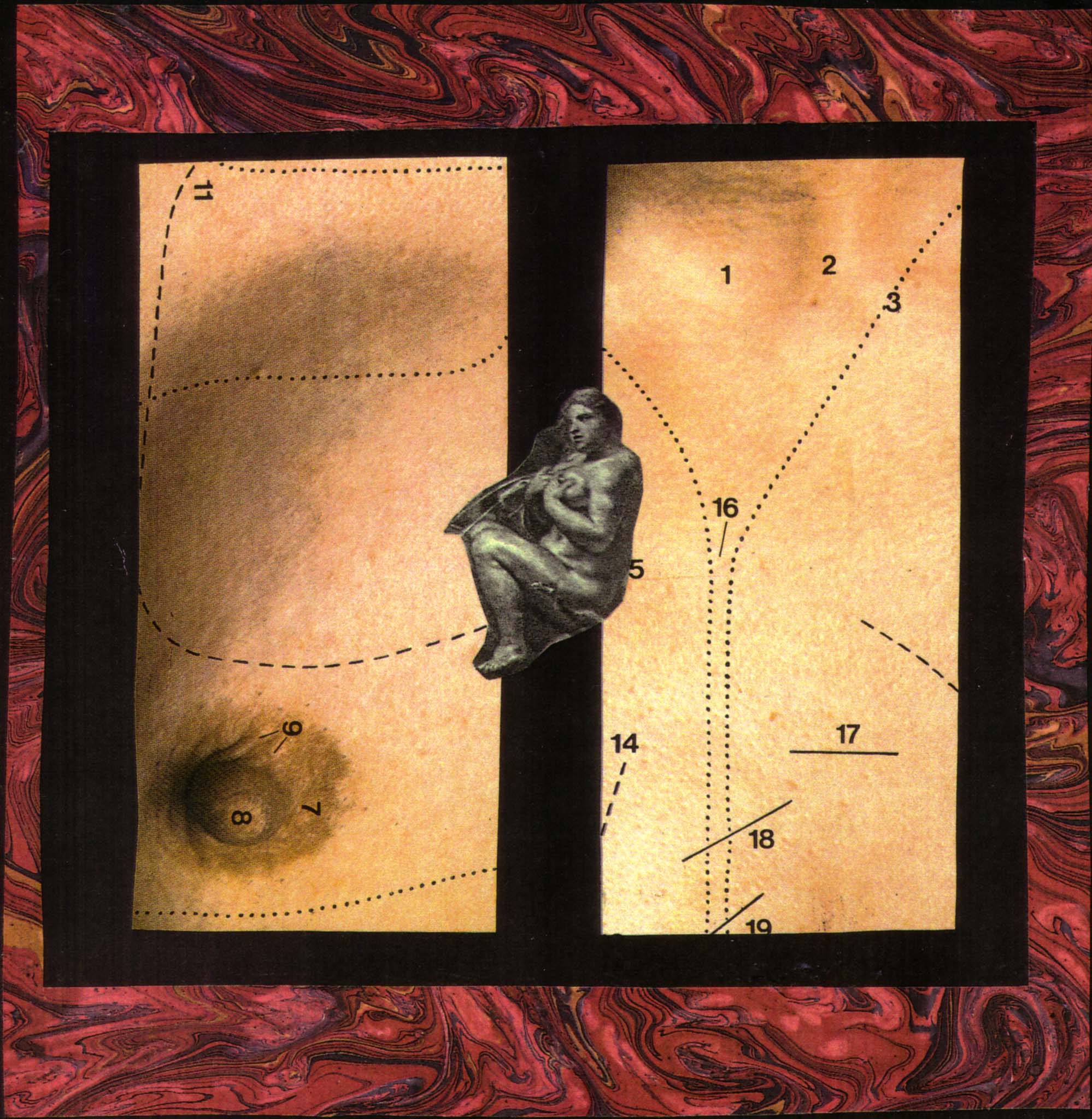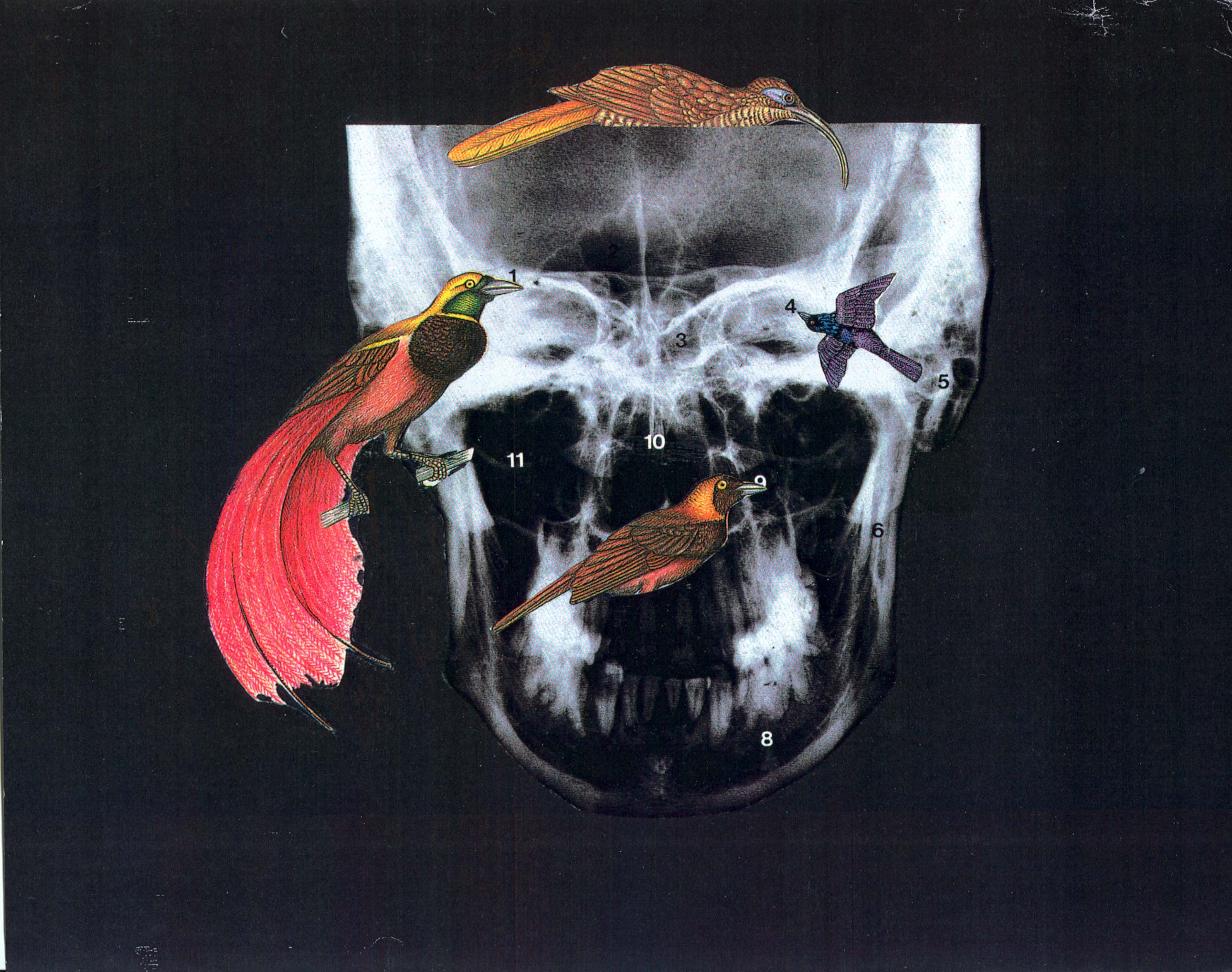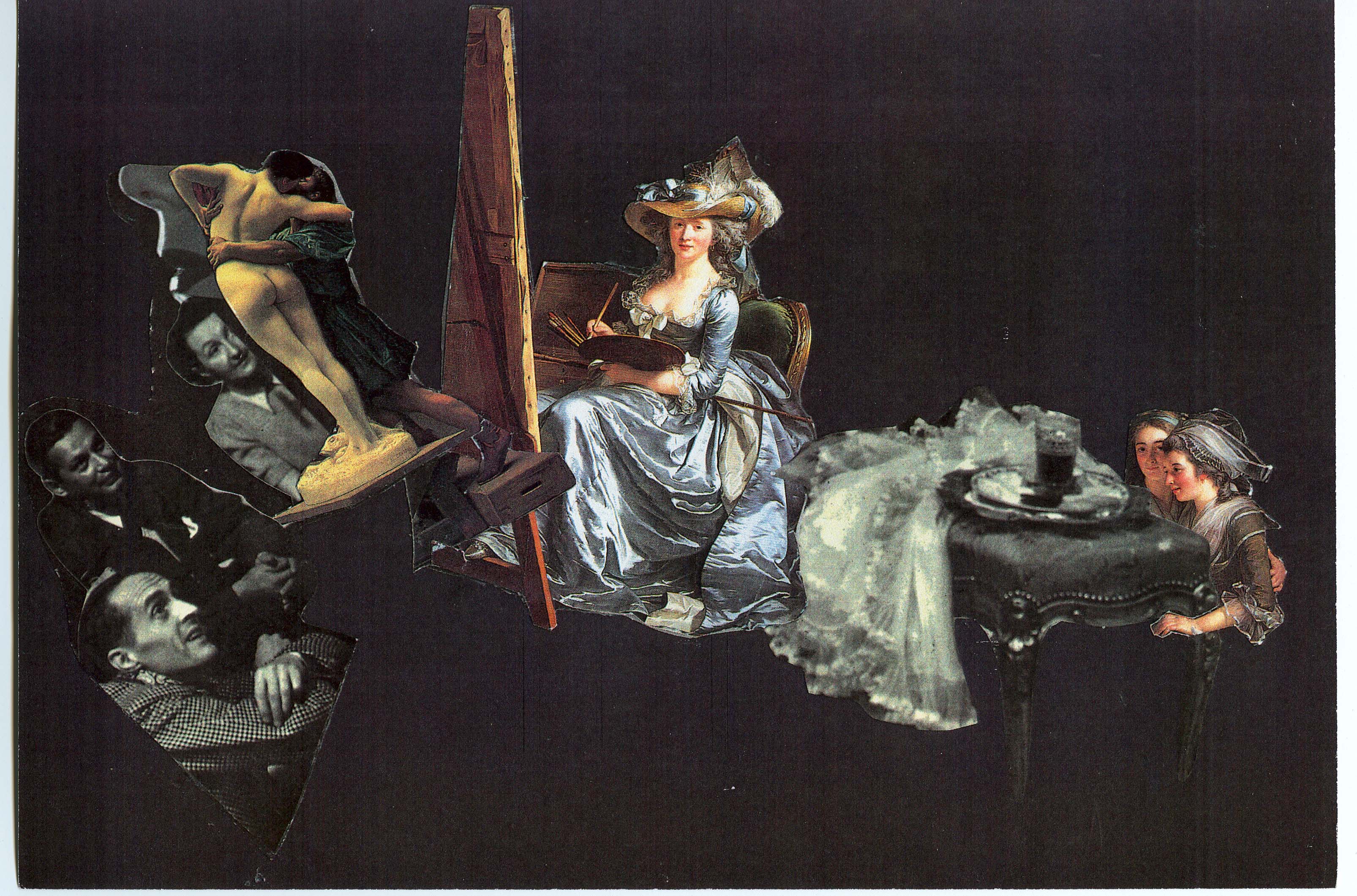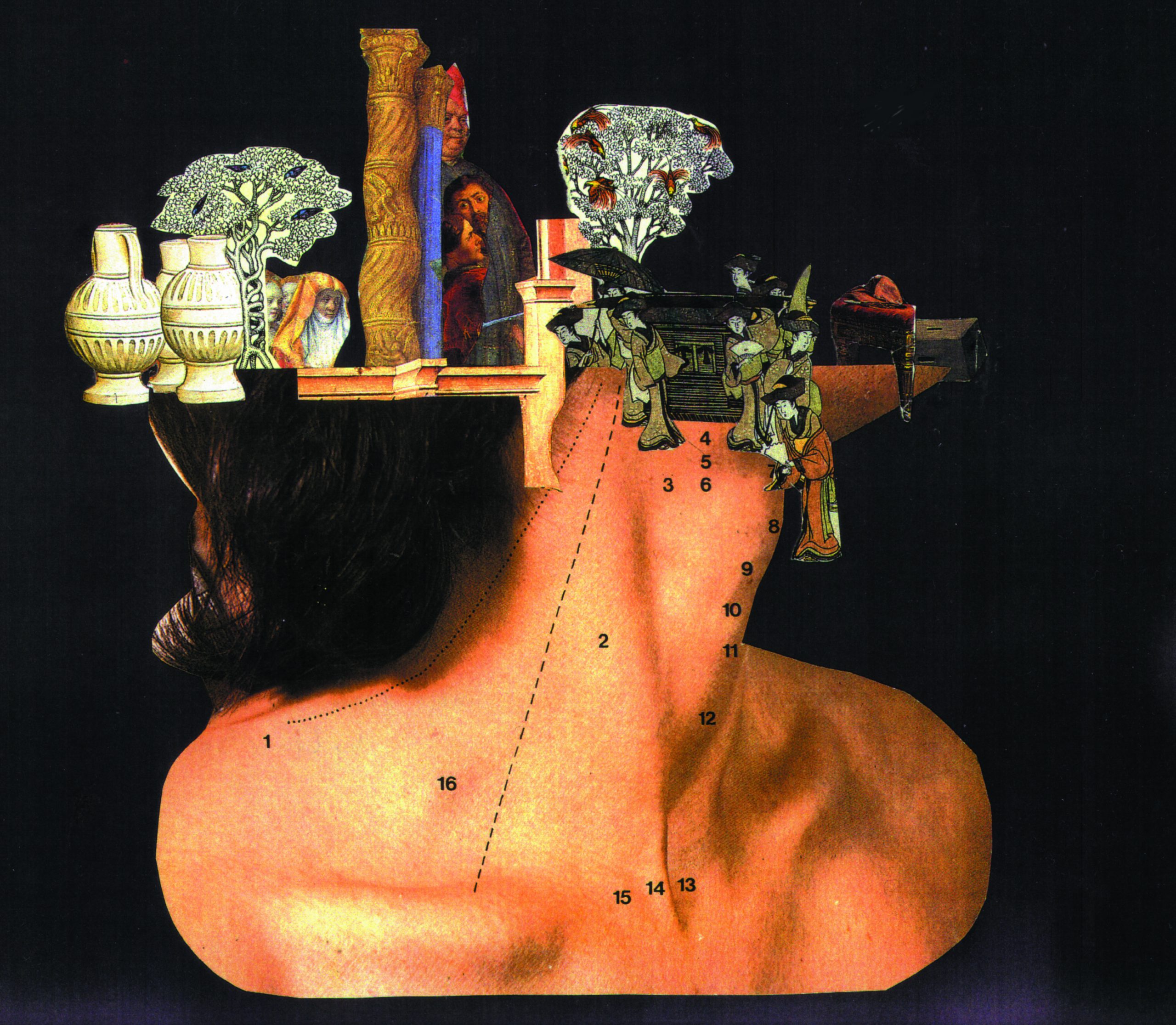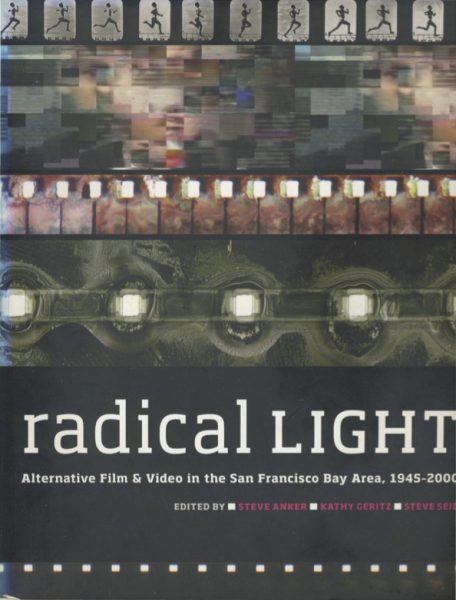
BAM/PFA’s Radical Light-book, film/video series, and gallery exhibition-places the San Francisco Bay Area as the epicenter of an explosion of avant-garde film and video in the second half of the twentieth century
Radical Light: Alternative Film and Video in the San Francisco Bay Area, 1945–2000
Steve Anker, Kathy Geritz, and Steve Seid
Publication date: October 15, 2010
https://bampfa.org/press/radical-light-alternative-film-and-video-san-francisco-bay-area-1945%E2%80%932000
This kaleidoscopic collection of essays, interviews, photographs, and artist-designed pages chronicles the vibrant and influential history of experimental cinema in the San Francisco Bay Area. Radical Light features critical analyses of films and videos; reminiscences from artists; and interviews with pioneering filmmakers, curators, and archivists. Special sections of ephemera-posters, correspondence, photographs, newsletters, program notes, and more-punctuate the pages of Radical Light. Among the contributors are Rebecca Solnit and Ernie Gehr on Bay Area cinema’s roots in the work of Eadweard Muybridge and others; Scott MacDonald on the Art in Cinema film series; P. Adams Sitney on films by James Broughton and Sidney Peterson; Stan Brakhage, Bruce Conner, Lawrence Jordan, and Yvonne Rainer on the Bay Area film scene in the 1950s; J. Hoberman on films by Christopher Maclaine, Bruce Conner, and Robert Nelson; Craig Baldwin on found footage film; George Kuchar on student-produced melodramas; Bérénice Reynaud on the films of Trinh T. Minh-ha and Leslie Thornton; Michael Wallin on queer film in the 1970s; V. Vale on punk cinema; Dale Hoyt and Cecilia Dougherty on video in the 1980s and 1990s; and Maggie Morse on new media as sculpture.
Pages 12-13, 158-161, 212-216, & 298-303 transcribed below
Form from the Fog: A Book Takes Shape
Steve Seid pgs. 12-13
“You have in your hands a compendium of critical thoughts, reclaimed that swept westward, part of that (not-so-)great manifest expansion, documents, backward glances, pointed scholarship, and rescued ephemera. The sum total of this compendium can be termed a history, centered on image-making practices particular to the avant-garde and springing quite unsurprisingly from a specific locale, the fogbound scape of the San Francisco Bay Area.
This history-though “cultural geography” might also apply-begins in the late nineteenth century, in 1878 in nearby Palo Alto. It was then that Eadweard Muybridgc began his pioneering experiments with the photographic image and the incremental improvements that would result in the motion picture. We, the editors, are quick to embrace those experimental tendencies so that our own history might claim a birth- place, no matter how romantic, fanciful, or appropriative that might be.
But our role here is to explain how this history found its natural form in these cornucopic pages. San Francisco’s topography-and by extension, that of the Greater Bay Area-lends itself to a certain rumination about verdant folds and gusty vales, about dusty undulations and rock-tumbled shores. These countless permutations of soil and stone arc known no better than by the fog that commingles intimately with each crevice, niche, and drizzly dell. To be a true San Franciscan is to become the fog, to become a familiar of the land in all its minute and diverse splendor.
This unspoiled diversity seems to nurture and promote the arts like no other region. Witness the historical presence of untamed artists-the poets, painters, composers, and moving-image makers- who are unified less by a central aesthetic than by a promiscuity of purpose that draws inspiration from the variegated surrounds. If the land can breed anything, as T. S. Eliot might say, the Bay Area breeds its own community of anarchic artists known for their indiscreet, unorthodox, and mongrelized tendencies.
The Bay Area also has the de facto (and damned) privilege of being perched on the edge of the continent. The unruly and enterprising hordes brought their own tradition not of settling but of unsettling a place, of bringing a restlessness and obstinance that, by reflex or reflection, rejected the normative, favoring the outlandish, the eccentric, and the self-possessed. Settling the West, then, was not a matter of transplanting the East and its civilizing force but more a matter of creating a refuge for the malcontents and revelators. Thus within its every crease and furrow, San Francisco seems to foster the wild thinking we associate with the arts.
Not surprisingly, irascible moviemakers and single-minded experimentalists were drawn to this place that has beckoned to artists, who in turn have found great nurturance in the area’s thorny hillocks and temperamental light. No apparent happenstance can lay claim to this attraction: It wasn’t just that out in Niles, Charles Chaplin created his signature film, The Tramp, in 1914, or that the next year, at San Francisco’s Panama-Pacific International Exposition, the “Scintillator;• a barge float- ing in the Bay packed with colored searchlights, may have constituted the first of the great light shows. Or even that Philo T. Farnsworth, the young television inventor from Utah, found quick investment in his enterprise from the city’s bankroll. It came more from a nascent awareness of the aesthetic notion that the land (and its human monuments) was already, in effect, an “enormous photograph”‘ beckoning to be viewed. Ever visionary, artists sensed the innate cinema of this place, and drew strength from it, while pursuing countless other cultural interests and points of reference from well beyond the Bay’s bounds. From the mid-forties on, the true focus of our book, a postwar influx of the artistically predisposed could be found squatting the charmed upheavals of the land, like phototropic fanatics turning toward light. They were filmmakers, many of them not-so-recovered painters and poets, ill at ease with cinema as an entertainment but rather fondly fixated on the apparatus, the alchemy of light and chemistry, and their own eccentric admixture that might make this all art.
The title of this book, Radical Light, emerges from this sense of a cinema that considers its origins in a substrate of emulsion and luminescence.The title also calls forth those early experiments with a medium still raw, unchecked, and as boundless as the visible world.
It should be clarified that these film artists weren’t the Indies of their time. They weren’t tenacious directors existing outside the studio system but still paying heed to the parameters of commercial distraction. Rather, these were artists of film who entrusted a time-based medium, an industrial apparatus, with the stuff of their enchantments. For their ecstatic visions to find form, something almost miraculous had to occur: the notion that cinema had an innate shape had to be banished. The apparatus itself was not predisposed to the mandates of linear time, classical composition,or blatant exposition. Plasticity was embraced, lyricism sent soaring,abstraction loosed,a painterly manner much trumpeted, the personal slyly promoted, and all this was unified by the discernible mark of the artist in a cinema handcrafted and poetically hewn.This was the “experimental” cinema of Sidney Peterson, James Broughton, Sara Kathyrn Arledge, Stan Brakhage, Lawrence Jordan, Bruce Conner, Jordan Belson, Bruce Baillie– the ranks would swell and, in time,be joined by a new wave of artists,some turning to video, others to installation.
But how does one capture the reigning sense of this place and, more specifically it’s community of sublimely inspired image makers? How does encapsulate without homogeneous reduction the plethora of artists who have contributed so much to the global enterprise of freeing the moving image from the stranglehold of the mundane?
In modern parlance, one might diversify. And that is what we have done:cut loose from the unified text to embrace a style of collage like portraiture in which studied critical writings by Scott MacDonald, Margaret Morse, Konrad Steiner, Rebecca Solnit, and Irina Leimbachershare the field with vintage posters and graphically intriguing newsletters. In this varied volume, first-person recollection,by distinguished media artists such as Bruce Conner, Cecilia, Dougherty George Kuchar, and Yvonne Rainer are counterpointed by artists pages, production stills, and pithy Focuses zeroing in on seminal films and videoworks. It should be noted that the latter were not gathered to construct a pantheon but to speak acutely about individual works. That said, the Focus writers form a pantheon of their own among them, J. Hoberman, Britta Sjogren, Tom Gunning, Bérénice Reynaud, P. Adams Sitney, and Marita Sturken.
Substantial and original interviews with local luminaries such as Sidney Peterson and Lawrence Jordan unfold as cohesive stories, while other interviews are deployed to refract singular moments from multiple vantage points. In the latter mode, the formative days of Canyon Co-op are relayed through excerpted conversations with Bruce Baillie, Chick Strand, Ernest Callenbach, Robert Nelson, Edith Kramer, and others. Kathy Geritz’s mélange of reminiscence about smalI-format filmmaking by a handful of significant Bay Area artists, Janis Crystal Lipzin, Scott Stark, Lynne Sachs, members of silt, Daniel Plotnick, among them, is a prime example. Steve Polta’s shotgun collage of quotes concerning the insurrection that inspired No Nothing Cinema is another; in Polta’s “Emergency Cinema,” you’ll hear from Lynne Marie Kirby, Nathaniel Dorsky, Carmen Vigil, Dean Snider, and many other witnesses to the tumult.
Histories abound as well, such as Steve Anker’s revelatory explication of Bay Area pedagogy in film, since the mid-forties; Deirdre Boyle’s take on the collective spirit of seventies video freaks; Eric Schaefer and Eithne Johnson’s account of the crossover between San Francisco’s expansive porn industry and the body’s liberation in experimental film; Steve Seid’s resurrection of the all-but-forgotten National Center for Experiments in Television; and V.Vale’s pointed essay on the infiltration of avant-garde media by the bristling punk scene-or was it the other way around?
Our polyphonic approach favors unreserved diversity over the cliche of a cohesive film-video community; media practices– subsets of genres, aesthetics, and cultural preference– are keenly dissected to reveal,in some cases, their indigenous origins. Konrad Steiner on poetics, Irina Leimbacher on the essay film, Craig Baldwin on found footage, Kathy Geritz on feminist film pioneers, Steve Seid on conceptualism and the video apparatus, Michael Wallin on queer cinema, Scott Stark on film performance and installation, Maggie Morse on the emergence of the digital: these essays of varied aspect and entry attest to the multifarious makeup of a region whose artistic community has refused easy amalgamation. Rather like the land itself, a media practice has emerged that would require a map of lake proportion to chart its every unsettling fold and seismic thrust.
And like a farmer’s almanac, this volume pays heed to the cyclical nature of aesthetic seasons, the native patterns of growth and the tidal pull of artistic change. We include a chronological aspect to gather weight, resonate for a spell, then recede. And where some essays bore deeply into the soil of a particular artistic practice, such as found- footage film or queer cinema, other essays scan the field, remarking broadly on the panorama of artists’ works and sustaining landmarks.
No survey of cinema culture would be complete without resurrecting visual artifacts that reflect the mood and aesthetics of the time. Reclaimed documents and rescued ephemera are arranged as “Cutaways” in each part, grouping captivating posters, fanciful newsletters, significant correspondence, candid photographs, and other objects that project light onto intriguing aspects of the history.
We hope this survey culminating in the year 2000 shows how film artists have drawn inspiration from the San Francisco Bay Area and, more important, how they in turn have enriched and transformed its generous culture. And this transformation can be felt far beyond the region, in the global circulation of cinema culture. What you have in your hands, then, is a diverse study of an experimental media community bound to a place but not bound by it.”
Radicalizing Vision: Film and Video in the Schools
STEVE ANKER pg. 158-161
San Francisco State University
FILM: 1963-1980
(Film added to Radio and Television in 1963; established in 1969) San Francisco State is a community-based school that draws from all sectors of the population and has one of the largest international student bodies of any American university. A swarming metropolis for the everyman and everywoman, State has long been a center of activism. The film program is a model of democratic education that supports all forms of independent filmmaking, and its early history was deeply intertwined with the turmoil that embroiled the country through the sixties. Here I want to focus on those parts of the program that were most instrumental for avant-garde and experimental filmmaking.
San Francisco State’s Department of Radio and Television (RTV) specialized in broadcasting and management during the fifties. In the art department John Gutmann, Jack Welpott, Herb Zettl, and, later, Fred Padula were also teaching Cinematography and Film as Art (much of it with an interest in the experimental), but by the early sixties this couldn’t satisfy the growing interest in film production and history. In 1963 RTV hired the UCLA-trained filmmaker Jim Goldner to join John Fell and Joan Reynertson, already on the program’s faculty, as coordinator of a new film area, and the department became RTVF.
Goldner wanted to bring the new spirit of independent filmmaking, as exemplified by Ricky Leacock and John Cassavetes, to campus. One of his first decisions was to purchase lightweight 16mm equipment, which was met with hostility by the studio-based broadcast
Faculty (who accepted 16mm only after Los Angeles colleagues supported the validity of hand-held camerawork). The broadcast film faculties continued to clash. Goldner recollects one meeting in which a news production faculty member asked, “Jim ,why are the film students so dirty? There’s film all over everything.” Goldner replied “That is the nature of filmmaking.” The new film courses proved immensely popular and helped convince the administration to build a media arts center, yet the schism deepened as students increasingly chose to specialize in film. Film students felt that the broadcast curriculum was conservative, and provocation permeated the said broadcast studio environment. Goldner recalls:
A film student, David Wescott, did a television show in 1964-65 in which Jesus Christ comes off the cross and buggers Santa Claus. Now we have two broadcasting faculty who are very religious,and I get called into chair Stuart Hyde’s office .He says,”Jim, from now on, all student work has to be pre-scripted and approved before it can be produced. told him, “This film was improvisational and couldn’t have had a script. That would be ‘prior restraint,’ and film faculty and students will have nothing to do with reviewing scripts.”
Though their backgrounds were largely in documentary and dramatic narrative, the film faculty wanted to support all kinds of filmmaking. In 1965 they hired Fred Padula, whose hand-processed, documentary, Ephesus (1965), portraying an African American church in Oakland, was winning awards. Padula, who first became excited about cinema after attending John Gutmann’s Art Movies screening series (1949-63), found “the surprises and chaos coming from stud who were experimenting exciting.” Padula complimented another newcomer, the KQED-TV filmmaker lrving Saraf. Padula focused experimental work and Saraf on documentary, but their classes often overlapped. Padula stressed untutored, intuitive technique:
I did not have a pre planned curriculum, a set notion of what film should be.These students came from many backgrounds: art, music, anthropology and architecture. They were all uninhibited and highly motivated and had no patience for anything that stood in their way.
Short, silent, black-and-white experimental exercises led to final productions with sound that students were expected to finish each semester. Tim Blaskovich, student (1966-69) and later staff technician (1982-92), recalls, “You might photograph things like popcorn. We put the camera on the stove with a pot of popcorn on it and let it run. In the earliest classes you didn’t know any rules-you were!ear” film grammar, exposure, and hand-held movement, in a sense, everyone would critique these rolls.”
Students could use small 8mm or 16mm cameras and makefilms for $10 or $20, or they could opt for more sophisticated equipment larger documentaries and narratives. This led to a stream of uncensored and idiosyncratic films. Some had no story and seemed crudely made others were documentaries dealing with hot issues. A head-on collision with the RTVF faculty was inevitable. “They didn’t see the point” Padula recalls. “They didn’t see experimental film as legitimate.” When Hyde asked students to abandon personal projects and make a group instructional broadcasting film, “the students started a rebellion, really raised hell,” Padula remembers. “They had a clear idea of what they wanted to pursue and felt like they were not able to within the Radio Television environment. Then RTVF chairman Hyde fired me.”
This act was short-lived. That 1966 spring semester concluded with San Francisco State’s second annual (and continuing) Film Final show, several hours of films interspersed with rock performances and hundreds of cheering students. Most were, to everyone’s surprise, experimental and had been made in Padula’s classes. Chair Hyde, dumbfounded but impressed, asked Goldner to notify the students that Padula would be reinstated. Hyde could no longer deny the excitement this new cinema was generating and began to realize the value of keeping it within the RTVF.
Radical impulses were cutting across all aesthetics by now, and Padula and Goldner produced nontraditional projection events off campus.
In 1965-66 the San Francisco Mime Troupe, led by Ronnie Davis and Peter Coyote, performed a scathing agitprop that led to Davis’s arrest.Troupe producer Bill Graham decided to sponsor benefits at Fillmore auditorium raise money for Davis’s defense and asked me to participate One student, Jerry Slick, had a band (Great Society) in which his wife Grace, as a lead singer, and they and other rock groups were added. The first night we were stunned when thousands of people showed up. Bands were playing downstairs, people were dancing, and the lights went out. Then my students and I turned on hand-held 16mm projectors from the mezzanine, projecting abstract loops, and those became the only light. After the second night, Graham came up to me excited, saying “This was amazing. Should we put on more of these?” and soon Graham began his concerts and light shows. (Goldner)
During the 1968 student antiwar strike, the film and radio and television faculties found themselves opposed to each other. The film faculty had reinforced its left-leaning sympathies by hiring the blacklisted writer Lester Cole and the animator David Hilberman, the leader of the acrimonious Disney strike, and there was general support from student activists. The campus had become a laboratory for spontaneous documentation, and portable cameras permitted on-the-spot, independent reporting for the first time. Records of numerous off-campus meetings include the riveting account of a student who was arrested and brutally treated in a paddy wagon.
The campus was sequestered for days.Hayakawa Was The President. There were cops on campus, helicopters overhead. People with nightsticks were trying to smash your skull and there were German shepherds, so people began documenting what happened. You’d grab a Bolex or Bell & I lowell in case there was a riot or sit-in or your classroom building was chained and locked that day. Experimental filmmaking certainly incorporated political awareness then. (Blaskovich)
My students believed in the strike, and many were out attempting to grab shots of the chaos. But most experimental class students wanted to continue to work on their own productions, and this led to my classes meeting off campus until strike issues were no longer a distraction. (Padula)
One outcome of that tumult was the final split between film and RTV, brought to a head after the revolt of irate film students, with the faculty encouragement of Fell and Goldner. When the film depart- ment was finally formed in 1969, Fell was its chair.
Filmmaking at San Francisco State was itself enmeshed with the radicalized climate. On one occasion Warren Haack (who later joined the staff) was asked by another student to record the latter’s protest after he was drafted. This formerly conservative student then shot himself in the foot, enduring an agonizing and blood-drenched wait for an ambulance. Haack filmed this with verite immediacy, and the resulting film, Selective Service (1969-70), became a mainstay of national screenings that still horrifies viewers. Haack recalls that at its Film Finals premiere, one viewer left the theater and “fainted flat on her face. The administration considered it my fault.”
In another incident, Ben Van Meter, a San Francisco State student, barely escaped arrest when he tried to retrieve his film from the Multichrome lab. Having filmed a female friend dancing nude, Van Meter was greeted by the lab owner, who-after stating, “You can’t show the pussy hair; you do that, they take away my lab and put us both in San Quentin”-called the FBI. An agent soon arrived and confiscated the film. The film was returned only after Van Meter wrote a letter to J. Edgar Hoover in which he explained that he had never sent this material through the mail and that the film was an art project in which the body parts would be covered over. After getting his material back from the FBI, Van Meter blotted out the objection- able parts frame by frame, and The Poon-Tang Trilogy (1965) became a celebrated critique of censorship.
Scott Bartlett and Tom DeWitt are two other students invariably mentioned by contemporaries as pivotal forces in the experimental scene. Each premiered first films during that 1966 Film Finals show, DeWitt with AtmosFear and Bartlett with Metanomen. Their visible drive set them apart from other undergraduates. “Bartlett was usually serious and intense, while DeWitt played the clown in ways that disguised his genius” (Padula). DeWitt had worked with Stan Vanderbeek in New York and is credited with inventing the printing techniques central to their work. Their next film, OFFON (1967), was collaboratively made and received exceptional acclaim for a student film. OFFON uses pulsating light, complex reworkings of film loops, multiple special effects, different film stocks, and sounds from a Buchla 100 synthesizer to create an extraordinary sensory experience.
Other faculty members expanded the presence of experimental film in the new department. James Broughton showed contemporary and historical work, focusing on archetypal imagery and dream interpretation; Gunvor Nelson taught filmmaking for a few influential semesters; John Fell, primarily a narrative film historian, focused on pioneers Maya Deren and Germaine Dulac; and Ron Levaco advocated alternative and experimental film in a global context. Robert Bell was a pivotal figure in keeping avant-garde film alive at San Francisco State from the seventies through the following decades by bringing key visitors to campus and through courses that focused on important classic and contemporary experimental work.
As at the Art Institute, the division between teacher and student frequently blurred since so many were learning or unlearning how the medium could be used. Blaskovich recalls, “A lot of students were older than the faculty, so students were teaching students and students were teaching teachers. Some students were born artists, like Scott Bartlett … you would hardly know he was a student.” San Francisco State had gained a national reputation as one of the hotbeds of radicalism by the late sixties, and Look magazine covered what was rumored to be an especially provocative course created by Bartlett. Warren Haack:
Scott taught a class where everyone got nude and filmed each other (in four locations), then the next semester a huge “sensorium” was constructed with fifteen movie projectors going at once, projecting all these images. The class was called Experimental Film, and we got three units each semester. Can you believe that?
Bartlett later shared his thoughts about filmmaking and art education at a 1970s conference, a utopian vision reflecting his sixties San Francisco State experience:
The filmmaker teachers gathered to this assembly are similar in one respect: their work is self-generated; born of an internal necessity to communicate that which requires the development of new modes of expression, new manipulations of the mediums available.
(Scott Bart “Teaching Making,” unpublished paper, SFAI Archive’s)
Bartlett proposed an idealized “personal program for creative exploration” organized around “the old craftsman-apprentice approach; unrestrictive, nonhierarchical system in which “the student would be allowed to transfer any time from one affiliated institution to another as his needs dictate.” Bartlett’s fantasy echoed an idealism and energy from a fading era. Padula recalls that by the mid-seventies students at San Francisco State were demanding traditional technical training could help them get employment in that recession era, and the earlier experimental approach had become “irrelevant.” By contrast, at SFAI where he also taught briefly, students remained more interested in self-expression than in looking for ways to make a living.
Despite the changing cultural climate, there were reminders of the politicized recent past. By 1974 gay liberation was in the air, some lesbian and gay filmmakers, such as activists Barbara Hammer and Michael Wallin, were boldly exploring their sexuality on film. Hammer “came out” at San Francisco State when she premiered openly sexual Dyketactics (1974) during Film Finals, and though generally felt unsupported there as a student, this film was greeted enthusiastically. A year later, Wallin’s thesis film, The Place Between Our Bodies, also depicted sex, this time between the filmmaker and his lover. At its premiere in that year’s Film Finals, it elicited fascination and horror. Padula recalls that screening, one of his last experiences before leaving
Wallin’s film was very graphic and personal, and there he was, sitting next to me. The department secretary was also sitting nearby, a middle-aged woman who knew him, since she dealt with all of the students. After five minutes she stood up, gasping, and walked out, totally horrified. Many other Faculty and students couldn’t take it and also left, but for me the film was fascinating.
Although a number of important avant-garde artists and scholars– among them Stan Brakhage, Bruce Conner, Peter Kubeika, Stephen Dwoskin, Annette Michelson, and P. Adams Sitney– they were exceptions to the dominant focus on documentary and dramatic narratives. Karen Holmes was one of the few students during those years who found the support needed to make experimental, visually oriented films. “If you were an experimental filmmaker at State in the 1970s,” she recalls, “you were on your own. My thesis advisers were from the art department as well as from film. I had more of a kinship with art.”
Reflecting the influences of Kubelka and Gunvor Nelson, Holmes’s work was concentrated and elegant, carrying some of her concerns with painting over to film. On graduation she was hired to teach part wasn’t discouraged by the program’s marginalization of experimental filmmaking:
The philosophy within the cinema department has always included support for all genres. So despite my experimental bent,I have to be able to critique narrative as well as documentary. My impulse may be to encourage students to fragment narrative patterns, make the structure a bit more oblique so one has to work harder to see it, to move us away from conventions that we all know and are comfortable with so that we can ask the viewer to discover and reflect on each film for its unique nature.
In 1981 Holmes became a tenured member of the faculty, with a specialty on the optical printer as a creative tool. She helped usher in an experimental rebirth during the 1980s.
CODA: 1980s-1990s
Film at San Francisco State (the department name changed to Cinema in the early 1980s) exploded with experimental film activity during the eighties by hiring artists and scholars with strong avant-garde sensibilities and by initiating an ambitious guest artist and scholar program Exciting and challenging new faculty members arrived, experimental theory-based essayists Trinh T. Minh-ha and Steve Fagin formal iconoclast Leslie Thornton, and, later, creative scholar Akira Lippit, personal filmmaker Greta Snider, and new narrative maker Britta Sjogren. Bill Nichols, a historian and theorist edited a book on Maya Deren, reinforcing this focus. Among an impressive range of visiting artists and scholars were narrative deconstructivist Mark Rappaport, autobiographical ethnographer Kidlat Tahimik seminal theorist Peter Wollen, feminist multimedia artist ValieExport and experimental filmmakers and former students Craig Baldwin and Jay Rosenblatt.
Staying true to the department’s origins, avant-garde forms existed with other forms of independent filmmaking, especially documentary. But when support for the guest artist program ended in the late eighties, emphasis again shifted toward traditional forms. The nineties saw the validity of avant-garde or experimental work challenged, often bitterly, in the face of an inevitable generational shift, continuing drops in budget that underscored the differences between film and digital technologies, and the realities of the job market, exemplified by an increased interest in Hollywood filmmaking. Films without an overt social or political message often had little support, and some filmmakers and scholars found themselves embattled with culture-based or skill-focused teachers and students.
Beginning in 1994, Cinema initiated an MFA track to further emphasize creativity and more deeply integrate current theory, and this program, along with the BA and MA programs, emphasized more of an experimental bent. Strong filmmaking that emerged from San Francisco State included a significant vein by students of color, especially African Americans. Cauleen Smith made assertive films and installations that probed her sense of herself as a young black artist; Portia Cobb and Ulysses Jenkins confronted social injustice as African Americans living in the aftermath of sixties activism; and Anita Chang used her experiences growing up as a Chinese American to consider Asian American identity. Queer filmmaking was embraced, and Ray Rea and Cathy Lee Crane playfully tested traditional comfort zones between sex and gender. Kathy Geritz and Irina Leimbacher, later significant curator- critics, studied in the program, as did the autobiographical essayist and future independent producer Jack Walsh, the found-footage psychodramatist Jay Rosenblatt, and the cross-cultural personal essayist Lynne Sachs. Early in the new century another experimental rebirth seems under way, keeping the spirit of adventure and radical discovery alive in one of the nation’s most pluralist academic cultures…”
”Smaller Is Better”: Bay Area Artists and Small-Gauge Films
KATHY GERITZ pg. 212-216
Until artists embraced the scale and unique characteristics of these formats, regular 8mm (dating to 1932) and Super 8 (introduced in 1965) were consumer products largely used to record family life and to mark celebrations and vacations. They measured one-fourth the size of 35mm, the most common theatrical exhibition format, and half the size of 16mm, the scale once used for educational, job training, and industrial films and by most experimental and independent filmmakers. Regular 8 and Super 8 are distinctive mediums, small and intimate, and often aptly referred to as small-gauge film. I interviewed a number of artists who have lived or worked in the Bay Area and used regular 8mm or Super 8 as a means of personal expression. Some artists talked specifically about making and exhibiting work in the Bay Area, illuminating aspects of a regional history. Others spoke about the properties they value in small-gauge film, comments that can also inform us as viewers. For some, the intention to be filmmakers originated with their families’ home-movie making, its amateur standing the source of their love of the medium. For others, small-gauge film is an artistic medium with particular qualities, particular ways of seeing-a singular language. Varied, yet overlapping, these artists’ visions of the medium extend from its heyday to its current endangered status. Their comments about the history and evolution of small gauge bracket this essay; the remaining quotations are grouped to follow the life of a film, from camerawork, film processing, and editing to screening.
EVOLUTION FILM HISTORY WITH A SMALL F AND A SMALL H
The Bay Area has long been home– a haven even– for small-gauge artists. Lenny Lipton began to write about Super 8 for Popular Photography in the early 1960s and went on to write primers on Super 8 filmmaking. In the 1950s and 1960s Bruce Conner turned to regular 8mm as a more intimate and home-based alternative to 16mm; Bob Branaman, in part, saw it as more economical. The first Gay Film Festival held in San Francisco, in 1977,opened with free screenings of Super 8 films-homemade erotica and experiments subverting the sexual and aesthetic status quo. Around the same time Joe Gibbons was making Super 8 chronicles of his own life, as well as using his unobtrusive camera to peek into the lives of other San Franciscans; and Sherry Milner and Ernie Larsen, more overtly political, were filming their lives in what might be the first American situationist film, ultimately a double- screen Super 8 projection.
While making Super 8 films, Janis Crystal Lipzin initiated teaching Super 8 production to eager SanFrancisco Art Institute students in 1978.At the time it was easy to buy small-gauge film and get it processed; some labs would even make prints. George Kuchar, who began making his lavish 8mm films as a twelve-year-old in the Bronx, moved to San Francisco in 1971 and in 1986 began working in 8mm video, claiming that home format to explore parallels between the weather and his digestion in his renowned Weather Diaries. Also in the 1980s, artists such as Peggy Ahwesh, Nina Fonoroff, Ellen Gaine, Peter Herwitz, Jennifer Montgomery, Danny Plotnik, and Jacalyn White were largely identified as Super 8 filmmakers, drawn to the medium for its particular low-end qualities, much as later artists would turn to pixelvision or cell phone cameras. They worked with diverse aesthetics that included abstract landscapes, on-camera confessions, and low-budget narratives.
Whether with the goal of working ecologically or exploring neglected film technologies, Scott Stark, Owen O’Toole (a member of Wet Gate), silt (the filmgroup consisting of Keith Evans, Christian Farrell, Jeff Warrin), and others in the late 1980s and the 1990s began to rescue discarded small-gauge cameras and projectors, as the medium’s demise seemed imminent. From 1998 to 2000 the Museum of Modern Art in New York mounted an exhaustive and exhilarating survey of small-gauge filmmaking, Big as Life, organized by San Francisco Cinematheque’s then-curator, Steve Anker, and MoMA’s Jytte Jensen, with selected screenings in the Bay Area. Today, against all odds, as regular 8 and Super 8 film stock, labs, and equipment are threatened with extinction, artists continue to work in small-gauge formats.
I DON’T SEE WHY Super8 should be a smaller part of film history than any other kind of film. Art is art, it’s not a question of institutional validation. -Ellen Gaine
SUPER 8’s RELATION TO film history may not be so much about film history with a capital
F and a capital H.Its relation to American culture maybe better articulated in terms of connections between the American family and travel photography, and the rise of affluent consumer culture in the postwar years, which made it possible for many people to buy consumer goods and appliances for their homes, including cameras of various natures.That is really the area of exploration that I think is most fruitful-a cultural history of Super8 rather than Super8 as part of a grand narrative that we may call film history. -Nina Fonoroff
I’M SURE THERE MIGHT have been people making 8mm films in the fifties, but I don’t remember seeing any of them at the occasional film showings in North Beach. When there were film programs– Christopher Maclaine put on programs at an Italian hall– they were all 16mm. You didn’t see 8mm projected in experimental film shows. -Bruce Conner
STAN BRAKHAGE HAD MOVED to San Francisco at that time-I think this was the early sixties. He said,”All this time I’ve been trying to figure out how to go from 16mm to 35mm, and there’s this guy named Branaman who showed me you can go in the opposite direction.” -Bob Branaman
MY INTENTION WAS TO produce the films in a lot of different formats so they’d be seen in a variety of ways. Between 1959 and1965 I did 16mm films and reduced them down to 8mm. I wanted to reach a larger audience, people who could purchase the seat at a cheap price, $5.00 or $7.50, and they could run them to death. -BruceConner
THERE WAS A SUPER 8 movement; it was like a religion. It was a worldwide subculture. It was partly ethnographic, partly people making feature films.It was very similar to the underground movement that was based on 16mm. In the late sixties and early seventies there were thousands and thousands of people all over the world involved. It was especially attractive to people in Third World countries where the low price of the medium was important and where there was no 16mm infrastructure.There was so much enthusiasm and love for the medium, and I was caught up in that. I wanted to tell people what I had learned. I felt there was a common cause. I really believed what Cocteau had said about filmmaking becoming a democratic medium when it wasn’t any more expensive to make a film than it was to write a poem.- Lenny Lipton
IN THE MID-1970s THERE were a lot of itinerant filmmakers moving around and sharing ideas, because it wasn’t something that you would learn in school. Hardly anybody who was teaching had done anything with Super 8. It really was a kind of guerrilla activity in a way, strangely supported by some of the film industry at the same time. -Janis Crystal Llipzin
I KNOW THAT SOME of my passion for 8mm film in general comes from my childhood experiences with it; I think on some level that’s what makes me a filmmaker. And then I guess politically or socially,I also value the fact that the cinema apparatus was made available to almost everybody- the fact that you could walk into a K-Mart and buy a camera and produce movies. -Owen O’Tool
THE EQUIPMENT REALLY WAS well constructed, especially the early equipment that came right after regular 8mm. My first Super8 camera is much sturdier than the equipment that came twenty years later, even though it was less sophisticated. In the halcyon days of Super8, there was so much equipment available and so many facilities that could actually take these little films. People were making them and giving them the kind of treatment that a larger format would be given.- JanisCrystal Lipzin
FOR ME, WORKING IN Super8 in the early 1980s in San Francisco was a continuation of the DIY [do-it-yourself] ethic and aesthetic of the late 1970s punk scene that I was part of as a teenager in Washington, D.C. I borrowed my first Super8 camera from Klara Lusardi, who I was playing with in punk bands in San Francisco and Berkeley from 1983 to 1985. I found Super 8 easy, gritty, poppy, expressive, and poetic, like the electric guitar. I loved how you didn’t need a whole band, rehearsal space,van,gas money, etc.,to do it. You could get your little three-minute spool of film (the same approximate time length of most great pop songs),your borrowed camera, your little splicer, and really do it yourself. -Leslie Singer
WHEN WE FIRST STARTED considering what it meant that we were working in Super8, it was something political, to be the champion of the small- that we were working in this tradition of these singular genera of film and that we were collaborating in small gauges. -KeithEvans
WITH SUPER 8 THERE’S always going to be that funky edge that gives it something more low art and sort of avant-garde and home movie-things that turn a lot of people off, because they are so funky, messy. That combination has worked well for me. -Peter Herwitz
IT REALLY WAS AN inexpensive way to make work that had the power of what we would consider mainstream movies– a way to create a sort of a bridge between the moments of one’s everyday life and the requirements of constructing a public work of art. -Janis Crystal Lipzin
AS AN EAST COAST outsider transient, who was quite lonely out there, I experienced the Bay Area rather toxic place, and the real toxicity of the chemicals and emulsion I found myself working with intimately paired inextricably with that rather paranoid vision of Bay Area beauty. I also associated my experience as being, ironically, quite impoverished economically despite the wealth of wonderful artists and sensual pleasures, and so Super8 met with my constricted means, and each roll had the value of a fetish object. So everything there was at once very dirty and very clean and bright. The pornographic uses of Super 8 were not lost on me, and it helped that I experienced the visual beauty of SanFrancisco as emitting a kind of pornographic light. -Jennifer Montgomery
SAN FRANCISCO IS A deeply creative town, where artists make the most out of scrap heaps. It was great to be part of the film-projector performance arts during the late nineties and early nothings; so many passionate people salvaging projectors and turning them all on at the sametime! Cinema performance is now even some sort of genre being discussed in graduate programs. The moody weather of the Bay Area contributes healthy skepticism of creativity, the unrest that turns over stones and finds things. At the same time all of California has become too expensive to live in; I don’t know how some people survive since the economic climate has changed so drastically. Selling projector parts on eBay? -Owen O’Toole
IN SOME PARTS PRODUCING inaccessible work in defunct gauges would be ridiculed; around here it’s just some minor lifestyle choice, like listening to LPs or playing the accordion or something. -StevePolta
CINEMATOGRAPHY: AN EYE ON THE END OF YOUR HAND
Small and lightweight, Super 8 and regular 8 cameras lend themselves to particular ways of working. Some artists have a favorite camera; others collect them at flea markets and yard sales, amassing a history of small-gauge equipment and drawing on the strengths and peculiarities of various models. Many filmmakers carry their cameras with them, using them in a diaristic manner to record daily life or their own thoughts and feelings. Often their presence can be sensed on-screen: the movement of their body, their voice offscreen, their shadow across the landscape. Then there are the filmmakers who stage low-tech extravaganzas with friends, providing all the glitz of a Hollywood production at a fraction of the cost.
YOU COULD HAVE A camera sitting there in your pocket, and whenever something occurred in your life-these little epiphanies-it was available. -Janis Crysta Lipzin
THE FACT THAT THE camera is light means one’s body can become a dolly, crane, or track. The presence of the human body behind the camera is very visible with Super 8 because of the way it is held or moved. -Nina Fonoroff
MY IDEA OF THE camera was something like an eye on the end of your hand that you could stick anywhere. – Bob Branaman
SMALLER IS BETTER -George Kuchar
IT’S LIKE PERIPHERAL VISION it’:s really out of the corner of my eye that I find something. It’s always something that reminds me of something else. It’s like a trigger. Once a thing becomes conscious, with a conscious intention, it’s almost dead. It’s very much in a half-awake state that things acquire something else; it’s very full of meaning. When you try to explain it, it’s completely elusive. -Julie Murray
I BECOME INSPIRED BY any number of different things, which then turn into images, which are then completely altered by the way I use the camera. The closer I stay to the way those images are in my head, the worse the film usually is. With Super 8 in particular, you have to be very sensitive to what happens around you. It’s about discovering poetic images, as opposed to planning them. -Peter Herwitz
ONE OF THE GREAT things about small portable media is the ability to do self-portraiture and to perform for the camera in ways that you wouldn’t feel comfortable doing say on a stage. -Owen O’Toole
IT REQUIRES MY ABILITY to be honest with myself first and to be open to what emotions I might feel other than what I think I should feel, or plan to feel. I have to approach filming myself, my family,and friends with openness and a willingness to show whatever comes up. People have described my work as being raw and honest, embarrassingly so, and I think that’s the reason for that, but it’s also my intention to have that kind of honesty. -.Jacalyn White
THE HOME-MOVIE ASPECT WAS a way of turning your friends into stars and not just people in the house, you know, cleaning or something. You got your friends, and places where they lived, but it was all done in a movie format, where they went through makeup and we had some lighting and we put in dramatic episodes. -George Kuchar
I SHOT MY FIRST films to music in my headphones.I had a primitive button on top of the Super8 camera trigger, so that every time I ran the cameraI also triggered the cassette player. Yeah, I had this on my ears way before Walkmans came about. -Andrej Zdravic
WITH MY WORK, I like to inhabit spaces and see what’s going on in them, and part of that involves being a little inconspicuous. Being able to capture the sound with the image– for me, that’s like magic. It really opens up the space that you’re looking at to hear the image and sound together and know that it was not doctored. -Scott Stark
ERNIE LARSEN AND I made the two-screen Super8 Disaster while living in Project Two, on Alabama Street in San Francisco in 1975-76. It was a moment when the Bay Area
was a burgeoning outpost of oppositional culture, a lively and often contentious scene. Influenced by situationism, I was interested in depicting the disjunction between Hollywood’s form of spectacular representation and what I regarded as the true site of disaster: everydaylife. The use of two screens to evoke that abyss seemed inevitable.Since this was very definitely pre-VHS we started smuggling our Super8 camera into theaters showing The Towering Inferno-using Tri-X to shoot off the screen. We also “appropriated” (in those days, we thought of it as theft) texts from many sources, including a story from Time magazine imagining in properly lurid detail the destruction of the Bay Area by an earthquake. In the midst of a deep recession, post-Vietnam, post-Watergate, the spectacle of disaster seemed at once a diversion from and the embodiment of the malaise of contemporary American Life. -Sherry Milner
MEMORY ISN’T SOMETHING THAT goes on forever. We don’t have memories in 120-minute reveries. We have memories in little bursts. That’s why a single roll of Super8 is so appropriate. -Owen O’Toole
THERE IS SOMETHING MAGICAL about affecting film as an artifact. This is the film that we buried, that we glued bird feathers to; this is the film that went through a camera at a specific place ,at a particular time. -silt
BACK THEN [in the late fifties and early sixties] we didn’t have any money. You could put one of the old reversible regular 8mm rolls in, and you could just keep turning it over and over; that way you could shoot the thing two or three times.I even used to hold up bits of glass and thingsI found in front of the camera and make my own little filters. -Bob Branaman
THERE ARE A LOT of idiosyncrasies, a lot of play-error-with the [used] equipment [we collected]. All of these eccentricities of the different kinds of equipment have really informed the language we employ. -Keith Evans
A LITTLE FILMO REGULAR 8mm camera my uncle had given me had an aura I couldn’t resist. On one of those rare warm San Francisco afternoons in 1987 I convinced my new boyfriend, John, to follow me to the roof of the Art Institute to make the first movie I would ever shoot in regular 8mm. My uncle had carefully explained to me that I needed to shoot half the reel one way, then open the camera, flip the reel and cam and shoot the rest. “After you shoot all three minutes send the film to the lab to have it processed and split down the middle,”he said.I surprised John by in him that we would both have to take off our clothes would shoot images of him for the first one and a half minutes of film, and he would shoot the second half of me. When I took the roll to the lab I begged them not to split the film as they normally would. There were two nude bodies on the same screen but also divided four equilateral frames. Within the parameters of the image gestalt, we are dancing together without touching. -Lynne Sachs
ONE ASPECT OF SUPER 8 that makes it distinct from other mediums is the cartridge. There is something about the fluidity, the ability to change stocks to put a cartridge on your shelf for a year. It creates impossible combinations on one reel, of different places, different cameras.-silt”
Where the Truth Lies:
Bay Area Essay Films and Experimental Documentaries
IRINA LEIMBACHER | pg. 298-303
“There is a strange breed of film that consists of a confluence of documentary, experimental, and personal-lyricaltraditi that intertwines questions of form and questions about the world. Having emerged early on, when the genre was not yet rigidly categorized by specific forms and functions, particular television slots, or funding sources, it encompasses numerous ways of cinematically seeing and projecting the world.
Already in the 1920s Dziga Vertov (Kina Eye, Man with a Movie Camera), Alberto Cava lean ti (Rien que les heures), Ivens (The Bridge), Hans Richter (Inflation), and others were making films that spoke of contemporary reality without merely reflecting that reality. They analyzed, deconstructed, and reconstructed their worlds using specifically cinematic techniques of framing, superimposition, temporal manipulation, and montage. They acknowledged the power of performance, poetry, and lyricism, and also of irony, metaphor, and wit. Thus before documentary was even a descriptor, cinema was emphatically engaged with the world. Film passionately embraced the world’s beauty, mourn edits cruelty, and mocked its injustice. With the late 1930s and the 1940s came increasing consolidation of cinematic borders between documentary and fiction and poetry, between ostensible fact and idiosyncratic opinion. But in the late 1950s and the 1960s there was a resurgence of films that challenged some of these boundaries, as well as the very idea of the presentation of “truth” with no acknowledged voice and no aesthetic form. In France in the 1950s Alain Resnais made Night and Fog, Jean Rouch shot Jaguar, and Chris Marker and Jean-Luc Godard began their careers. In Cuba in the 1960s Santiago Alvarez made radical newsreels, and in Argentina Fernando E. Solanas and Octavio Getino were developing a “Third Cinema.” In the same decade in Germany Alexander Kluge and Ha run Farocki made their first politically provocative and formally inventive films. These are just a few of the works that took up and confronted the world, acknowledging their position and declaring their stakes. Not only were the voices of the participants and the makers often reflexively brought forth and the processes of exploration and construction recognized, but reappropriation, irony, and lyricism were seen as allies-not enemies-in the analysis of social realities.
What shall we call such films? Experimental documentaries, since “reality” is at stake and form is explored rather than given? Essay films, since the inscription and description of the world are fore-groundedand often problematized? Personal documentaries, since experience and knowledge are often embodied through the voices or traces of the makers? Part of the fascination of such work is its elusive and eclectic nature, its refusal to be categorized and its refusal to categorize or to exclude anything a priori from the realm of relevance to the real. Writing about the visual essay, Michael Renov suggests a possible definition: the speaker and the speaking, the filmer and the filmingare an intrinsic part of the essay, “a representation of ‘historical real’ (digressive, fragmentary) through sound and image in a manner which embroils the subject of enunciation.”‘ While such films explore our shared social world, there is a simultaneous investigation of,and perhaps even a challenge to, the cinematic means of doing so.
Though there is no single or even dominant tradition of the experimental documentary or essay film, California has long been home to some of the most accomplished and diverse of its practitioners: James Benning, the late Chick Strand, Jean-Pierre Gorin, and Steve Fagin in the south, and artists such as Craig Baldwin, Trinh T. Minh-ha, Jeanne C. Finley, Lynn Hershman, and the late Marlon Riggs in the north. In the Bay Area the explosive collage films of Bruce Conner or the lyrical portraits of people and places by Bruce Baillie in the 1960s can be seen as precursors to this work. San Francisco State University, where many of the artists discussed in this essay were faculty members and/or students at one point in their careers, was a breeding ground for various forms of experimental documentary beginning in the tumultuous late 1960s and continuing throughout the seventies and eighties. There seems to be something about the BayArea- the diversity of its communities, the eclecticism of its exhibition spaces, its disdain for convention- that is conducive to experimentation that challenges notions of the world and the paths of our knowledge to it.
The decade between the mid-eighties and mid-nineties was especially fruitful for Bay Area experimental documentary, as can be seen in the wide-ranging and prolific output of films and videos by Baldwin, Finley, Fagin, Trinh, Hershman, and Riggs. While these mediamakers’ formal and political strategies, as well as their choices of subject matter, are incredibly diverse, they all, in their own ways, turn documentary conventions upside down and challenge naive and circumscribed notions of “truth” or “fact.” Whether explicitly or implicitly, they take on the traditional media and its claim to authority, and they ironically play with their own discursive strategies Many of these artists work across and between genres, between experimental and conventional documentary (Finley, Riggso)r between experimental documentary and experimental narrative(Fagin,Trinh, Hershman). In fact, their work simply cannot be pegged down, as they simultaneously explore and expand the very language and scope of moving images.
Paul Arthur writes that essay films “hold up for scrutiny precisely those conventions that other documentary genres suppress and, in that sense, fuel meta-critical speculation on nonfiction cinema’s blind spots.”‘ Certainly this can be said of these Bay Area films. They all undermine traditional documentary authority, the underlying claim to veracity and representational transparency that is the premise of most nonfiction film. This is done through the heterogeneity of their materials-their images and sounds, both found and original-and their modes of address, which belie the usual forms of “discourses of sobriety” in favor of irony, intimacy, performance, or poetry. The subversive combination of elements in these works refuses any simple reading and calls instead for a complex, multifaceted attitude of uncertainty, constant curiosity, and a willingness to let go of the habits that constrain our attitudes toward media, the world, and ourselves. Indeed, the eclectic Bay Area experimental documentaries of the mid-eighties to the mid-nineties teach us to watch images skeptically, to listen to voices usually excluded from mainstream media, and to appreciate the aesthetic force of film and video and the worlds they embrace. Here I shall touch on just a few of the works of this period.
The found-footage alchemist Craig Baldwin began working in film in the mid-1970s and subsequently did graduate work at San Francisco State’s film department in the 1980s. In the spirit of some of the collage films of Bruce Conner (with whom he studied), as well as the situationists, Baldwin subversively plays with images and sounds, using techniques of repetition and ironic juxtaposition to estrange us from our habitually passive viewing attitudes. In the mid-1980s his work became explicitly political, his found-footage collages wryly commenting on not only the ideological content of images but also the unconscious imaginary at work in U.S. neocolonialist foreign policy. Both RocketKitKongoKit (1986) and Tribulation 99:Alien Anomalies Under America (1991) set a combination of reappropriated educational, industrial, sci-fi, and other kinds of cinematic detritus against an onslaught of disembodied commentary that ostensibly explains and narrates what we see. Yet we quickly realize something is awry: these commentaries don’t really explain at all, and the footage slips and slides between possible “fact” and egregious fiction. Rather than conventional explanation, the combination of images and voice-over satirizes the very act of explaining and the very idea of fact, drawing on humor to call critical attention to mainstream history’s ideological lacunae and Manichaean excesses.
RocketKitKongoKit uses disembodied narration in the conventional voice-of-god documentary tradition alongside its found visual mate- rial to “tell” us about various moments of Western military-industrial and CIA involvement in Zaire (now the Democratic Republic of the Congo). However, we become more and more unsettled by the narration, knowing some of the events are true and suspecting others are too outrageous to be possible, especially when narrated alongside the images, whose sources range from seemingly documentary footage (but of what precisely?) to1950s science and educational films and Tarzan and other movie escapades. The film begins at the end of the colonial period and recounts a series of political events, including President Mobutu’s lease of one-tenth of the country to a West German rocket firm, and culminates in a disastrous Cold War Armageddon set one year after the film was completed. The narra-tion, subverting the typical college-educated-white inflection that we have been trained to associate with authority, shifts from one voice to another, distinguished by U.S.,French, German, and Congolese accents and hence suggesting varied ideological or geopolitical positions. In addition, frequent jokes made through the sound-image juxtapositions constantly unsettle our ability to decide how, precisely, we should be engaging with the film and the information with which it barrages us. Is this serious or funny or, more disconcertingly, both? Taunting and teasing us with its parody of documentary form, RocketKitKongoKit speaks eloquently about power, whether that power is military, industrial, or simply discursive.
Viewers of Baldwin’s films are ultimately forced to read everything against the grain. The fissures between text and appropriated image, between mode of address and message, between political facts and apocalyptic fantasies (and we are not always sure where one ends and the other begins) all work to destabilize any single claim to truth. Yet RocketKitKongoKit and Tribulation 99 are not mere postmodern pastiche; the historical events and political turmoil that underlie them are all too real. Instead they are lessons in critically approaching history, ideology, and media, lessons wherein laughter and lies play crucial pedagogical roles.
Jeanne C. Finley’s experimental videos of this period also often mock documentary conventions while offering sardonic social commentary. Coming from a background in photography, Finley began working with video in the mid-1980s and was hired at the California College of Arts and Crafts in 1988. Her works of the late 1980s, as well as several of those codirected in the 1990s with her collaborator John Muse, incorporate a characteristic mix of psychic anxiety, political critique, and humorous, ironic distance. Unlike in Baldwin’s work, the anxieties and paranoias in Finley’s oeuvre tend to be articulated at the level of individual bodies and experiences and only secondarily at the level of grand political narratives. Some of her work of this period incorporates appropriated footage or texts, and these are often used alongside her own staged scenes. For example, the short Common Mistakes (1986) intersperses excerpts from an educational film about childhood safety-in which unsafe games lead to horrific accidents-with short segments about “mistakes” resulting from political or cultural practices that have momentous social consequences: the forced assimilation of Native Americans, the medical use of lobotomies to “cure” mental illness, and nuclear contamination at Three Mile Island. Linking events of such entirely different magnitudes and forms and juxtaposing melodramatic footage of wounded children with acted testimonies of witnesses to socially cataclysmic events create a disturbing tension. The irony is effective in making us aware of representational conventions and of our own psychological investment in various forms of historical storytelling. Finley’s piece activates our critical faculties and emotional responses, as well as a new awareness of their imbrication.
At the Museum: A Pilgrimage of Vanquished Objects (1989) is both a critical documentary and a documentary parody, somewhat in the spirit of Luis Buñuel’s 1932 Land without Bread. An omniscient and invisible male narrator, with an exaggeratedly mellifluous tone of voice, takes us on a tour of “a California museum” (in Oakland). However, rather than the institutionally legitimizing discourse we might expect from such a narrator, this one analyzes, mocks, and historically recontextualizes several of the items on display. These include a seemingly innocuous nineteenth-century painting linking progress to white western expansion; Dorothea Lange’s famous portrait of a dust bowl sharecropper and her children (actually a California family, as the daughter-now grown-explains); a model of government housing for workers at Hunters Point Naval Base; and a multiethnic, multiracial plaster diorama of a happy group of so-called California dreamers. Each segment is a brief exposé of the display, revealing concealed ideologies and hidden histories of the collected and reified objects. Complemented by written excerpts from James Clifford’s The Predicament of Culture, the text of which periodically unfurls across screen, the piece carefully constructs an uncompromising critique of the very premise of museum collecting and decontextualized display. It ensures that we will never experience museums, or any other factual presentation of “cultural artifacts,” including the voice-over documentary we are watching, in the same way again.
Both Baldwin and Finley use irony and exaggeration to subvert naive beliefs in truth and documentary authority. Steve Fagin, who moved between San Francisco and San Diego during the period 1987-2003 and taught film history and theory in San Francisco State’s film department from 1978 to 1986, also analyzes and mocks conventional forms of authority and mass-media representations of reality. Having worked as a video artist since the mid-eighties, Fagin uses an eclectic and multilayered formal palette to create highly inventive, classification-defying videos. His early works such as Virtual Play (1984) and The Amazing Voyage of Gustave Flaubert and Raymond Roussel (1986) construct and reimagine psychic, philosophical, and literary landscapes drawn in part from his examination of and fascination with figures such as Lou Salomé, Flaubert, and Roussel as they simultaneously engage in a complex reflection on video’s (as well as history’s) discursive processes. With postmodern flourish and delight Fagin mixes textual, painterly, cinematic, and historical references into a collage of wildly imagined and roughly acted scenes, tableaus, and off- and on-screen testimonies.
Several of Fagin’s works also interrogate geopolitical power relations. The Machine That Killed Bad People (1990) is a critical parody of televisual rhetorical strategies, more analytically elaborate and stylistically baroque than that found in Baldwin’s or Finley’s works. It isa penetrating examination of contemporary Philippine politics in the context of U.S. neocolonialist domination. Fagin says that he wanted “try to write a history … using the stylistics of infotainment television” and “initiate a discussion of the CNN-ification of the planet.”‘ The dominant trope of the two-hour video is that of a news broadcast on the television station KSKY, replete with bleeding-eye logo ,attractive anchorwoman, shopping ads, travel suggestions, and weather announcements. Within and around the “news” broadcasts, Fagin uses a wide array of material: archival footage of the revolution, the Marcos’s home movies, fictionalized Pixelvision rantings and readings of an American journalist stuck in his Manila hotel, and Fagin’s own “direct cinema” footage and interviews shot with political activists as well as guerrilla fighters in the New People’s Army in Mindanao, to name just some. These diverse and compelling fragments of “fiction” and “fact” (and we are forced to see the fictions in the so-called facts and the facts embedded in the so-called fictions) are alternately contained, interrupted, and deferred by the anchorwoman’s address and shuffling of papers: “Coming up … ,” “Please stay with us,” “Next: An Amazing Story.” Weather reports, shopping channel sound bites (cleverly reappropriated or reinvented, with corrupt politicians featured as the big “shoppers”), and the constantly reiterated channel identification for KSKY punctuate the piece, turning recent Philippine history into bite-size spectacles and destroying any possible sense of overarching narrative or political closure.
Fagin’s use of diverse video formats and his eclectic collage of footage, rhetorical registers, and truth claims create a dystopic cacophony of fragmented and competing realities. There is no obvious controlling voice in this piece, only a shocking, discordant polyphony. We work hard to discern a position, to forge our own, for we have become as fractured as what we see. Underlying this cacophony, of course, is a deft critique of the omnipresence of U.S. neocolonial power and the televisualization of history. The use of Marcos home movies, including shots of an assassination attempt on Imelda, become both ironic spectacle and a morally obscene, aesthetically sensuous interlude when set next to Fagin’s straightforward interviews with political activists in various regions of the Philippines. His observational footage of the healer Alex Orbito’s psychic surgery as he extracts a bloody mass from an American patient, the least “believable” footage from a Western epistemological stance, becomes yet another challenge to our faith (or its lack) in the image. No part of this video, which Fagin has called a cross of “Brecht with Ted Turner,” can be read as simply “real” or simulated, and it is an explosive and darkly humorous tour de force of media criticism.
As deeply subversive, but without the parodic or satirical elements so central to Fagin, Finley, and Baldwin, are the essay films of the writer, poet, and composer Trinh T. Minh-ha, who was also on the faculty of San Francisco State’s film department in the late 1980s and early 1990s, before moving to the University of California, Berkeley. Her earlier Reassemblage (1982) and Naked Spaces-Living Is Round (1985) were provocative and formally elegant films shot when she was living in West Africa. Reassemblage, whose images and sounds circle around women’s lives in various parts of Senegal, challenged rigid notions of documentary truth, ethnographic authority, and the bland visual and aural conventions of most nonfiction work and was a source of much controversy in anthropological circles. Naked Spaces, with its multiple voices and lyrical visual and verbal reflections on forms of place, space, and knowing, likewise challenged reductive norms of documentary while exploring West African architectural forms.
Surname Viet Given Name Nam (1989) is Trinh’s first film both shot and edited in the Bay Area and her first sync-sound work. Whereas the works of Fagin and Baldwin develop through an accretion of parody and postmodern excess, Trinh’s Surname Viet, also on one level a work of media criticism, gently transforms itself and us in a spiral of constant reframing, revelation, and refinement. Full of sensuous visual and aural rhythms, colors, and textures, the film uses archival images, songs, proverbs, poetry, and stories of women in Vietnamese history and literature, in addition to the interviews around which everything else is woven. Like its antecedents in her oeuvre, it also embodies and enacts a rigorous epistemological critique.
Surname Viet is structured to provoke a series of revelations in the viewer. Things are never what they seem: whenever the frame is enlarged, figuratively and/or literally, we realize that there is much more than first meets the eye and ear. Early on, graceful young women in a photograph are revealed, when the frame shifts, to be holding guns. Later, interviews are discovered to have been scripted and acted. Almost every certainty and expectation in this film is subverted, so that watching it becomes a process of self-discovery for the viewer as well as a discovery of some of the manifold forms of Vietnamese women’s experiences, cultures, and histories. Based on a series of oral interviews of South Vietnamese women published in French, the film elegantly reenacts these interviews in beautifully shot and unusually framed sequences that slowly under- mine our belief in their spontaneity. When texts begin to appear on screen, the subtle differences between what we read and hear again force us to question our assumptions. (Why are these texts here? we ask. Why is there a discrepancy between what we hear and what we read?) Only much later is it revealed that these are not professional actresses but Vietnamese immigrants living and working in the Bay Area; their real lives are explored in the last part of the film. In this section we see how the women experience, defy, and/or perform in accordance with a number of cultural expectations, how they articulate themselves and their sociocultural histories in different ways. Trinh, who holds that one cannot theorize about but only with film, has created in this work a compelling philosophical commentary on the nature of our expectations of and access to “truth,” as well as a critique of any kind of essentialism, whether of culture, gender, or knowledge. With the slow, revelatory unfolding of Surname Viet Given Name Nam, we experience viscerally the tension between the world and its representations. Nothing is fixed, nothing is certain, neither the labels and names we use to speak about cultures and politics nor, most of all, our own assumptions.
Trinh’s piece obliquely incorporates bits of her own family’s stories in its larger field of excavation and reflection, but it is not a work enunciated in a first-person or confessional mode. Other Bay Area experimental works of this period, however, explore forms of first-person direct address in innovative and challenging ways. While a focus on personal experience and the acknowledgment of the political stakes of personal narrative had become common in some feminist and political documentaries of the 1970s and 1980s, the BayArea artists Lynn Hershman (now Lynn Hershman Leeson) and Marlon Riggs developed this form in very distinct and extremely provocative directions.
Hershman was already a major figure in California installation and performance art when she became director of the Inter-Arts Center at San Francisco State in 1984. (She had also received her M.A. there.) In the 1970s she had created a number of radical site-specific pieces, including an installation with Eleanor Coppola in room 47 of the low-rent Dante Hotel in San Francisco and a series of twenty-five window installations for Bonwit Teller in New York. She had also created and enacted persona pieces such as Roberta Breitmore, who led quite an adventurous life, on and off, with Hershman’s help for seven years. In the 1980s she began to work in video and interactive media, continuing to create complex fictional female characters in works that confounded the usual boundaries between fact and fiction, self and alter ego, viewer and participant. She herself became the explicit subject of her confessional series The Electronic Diaries.
Begun in 1984 and continuing through 1996, TheElectronicDiaries is a first-person excavation of Hershman’s psyche and personal history at the time. The series was later reedited (and recontextualized) by Hershman into a single work, but this discussion is based primarily on the original tapes, released singly. These tapes of different lengths are keenly attentive to the complex performative and cinematic aspects of testimony and confession. On their video-screen surface, the first three parts of the series- Confessions of a Chameleon (1986), Binge (1987), and FirstPersonPlural (1988)- consist of an outpouring of diaristic declarations and reflections addressed directly to the camera by Hershman, sitting alone and often somewhat self-consciously, in close shot. Each of the tapes focuses on one or 1\10 core issues and grapples with the complex nature of identity,memory, desire, and self-revelation. Her reflections explore the ambiguity of childhood memory and fantasy, the trauma of abandonment, body image, eating disorders, incest, abuse, and the cross-generational effects of the Holocaust. These are all spoken directly and insistently to the camera, as if to an intimate witness, who is both herself and her imaginary (now real, as we watch) audience.
The obsessive and often disturbing revelations of her current and past personal struggles, however, have been carefully recomposed into a fast-paced, fragmented video collage. In several instances she manipulates her image, using the video effects of the day to double, mirror, and multiply her “self” in many ways. Images are placed within images, and freeze frames and cuts dissociate her voice from her body. In her visual deconstruction and reconstruction of her own image and her fragmentary, sometimes disjointed but nonstop narration, she seems to throw into question the very notion of the unitary subject and the possibility of cohesive identity. She uses the medium of video to question and analyze and also create a/her persona in the context of a troubled family history. At one point Hershman asserts that she only tells the truth, yet the very notion of truth is troubled by this assertion as well as by her attempts to disentangle and come to terms with her past and its shifting representations. Confession and performance blur in these tapes, or perhaps they are one and the same. Her interlocutor, too, is multiple, at once herself alone and us, the future anonymous viewer. Periodically she disrupts her monologue with a disconcerting question in the second person: What was your first sexual experience? How did you feel? What about your body? The camera, the screen, we ourselves now watching and listening are integral elements of the piece, as our self-identity is fractured by our simultaneous presence and absence, by our dispersal among Hershman’s and our own myriad representations.
Subsequent segments of Hersh man’s Electronic Diaries incorporate other voices and testimonials as well, those of fellow travelers in arenas of shared struggle, such as the battle with cancer in Shadow Song (1990) and women who have survived experiences of traumatic violence in Recovered Diaries (1994). The earlier video interweaves an African American friend’s testimony of his experience with cancer and Hershman’s own diaristic entries on her recent discovery of a brain tumor. Filmed over several months, the piece poignantly but also disturbingly juxtaposes their shifts in attitude over the course of their illnesses, as one dies and the other survives. The later piece seems indicative of Hershman’s gradual extension out from the realm of individual pain and trauma to her appreciation and analysis of its societal roots and the potential of collective empowerment.
Drawingon very different strategies, Marlon Riggs in Tongues Untied(1989) also sought out radically new forms to express profoundly personal experiences. For Riggs, it was the collective force and political ramifications of testimony, in all imaginable manifestations-shared as well as individual, artistic as well as straightforward-that were crucial. A professor in the Graduate School of Journalism at the University of California, Berkeley, beginning in 1987 (also where he received his M.A.), Riggs also made more traditional documentaries that were remarkable in their subject matter, scope, and form. In Ethnic Notions (1986) and Color Adjustment (1991) he analyzed racial stereotypes of African Americans, first in various forms of popular culture over the past century and a half and then in commercial television from the late 1940s through the 1980s. Alongside these investigations of insidious mass-culture stereotypes and representational practices, Riggs turned to the project of representing and presenting one of his own communities, that of black gay men.
Tongues Untied mixes personal testimonies from a number of voices with narrative reenactments, poetry, performance, snapping, voguing, observational footage, and archival sequences. This piece eschews the supposedly natural and unrehearsed speech that so many political documentaries rely on to instead deliberately and proudly articulate its joys and suffering, its hope and rage. Not only heads but bodies talk. Full bodies-naked, clothed, and in drag-move, dance, recount, or rhythmically recite their stories in their own chosen gestures and words. In a euphoric whirlwind of intensely moving performances that make no concessions to mainstream norms of “proper language” or television standards of taste, Tongues Untied unabashedly lets loose many tongues, calling out and affirming their pains and pleasures, fantasies and fears, and grappling with desire, sex, politics, and death. The piece demands to be heard, engaging us viscerally and insistently, as it enacts identities and histories as part of a collective, creative, and politicized process. Part of the outcry and shock that Tongues Untied elicited from politicians and public television administrators at the time of its release stems from the fact that it was clearly made for, with, and by its own community of black gay men. It refused to compromise its language and its form for middle-class white and heterosexual television audiences. Rather, it is a cry of love, compassion, and rage in the context of racism, homophobia, and AIDS. It addresses and engages its own community on its own terms, and the rest of us are lucky enough to be invited along.
With the exception of Riggs, whose untimely death in 1994 was a great loss to the Bay Area and to the field of documentary as a whole, each of the artists discussed here is continuing to work in the realm of moving images, even if some have shifted toward fictional or installation work. At the same time, in the early 1990s, other, younger filmmakers (many of whom had studied with one of the artists above) emerged in the realm of essayistic and experimental nonfiction in the Bay Area-makers of short films and videos such as Lynne Sachs, Valerie Soc, Greta Snider, Cauleen Smith, Claire Dannenbaum, and Erin Sax. Like their predecessors, they too are extremely diverse in their representational and political strategies, their aesthetic predilections, and the emotional charge of their work. Soe, with Cynsin: An American Princess (1991) or Picturing Oriental Girls: A (Re) Educational Videotape (1992), and Smith, with Daily Rains (1990) and Chronicle of a Lying Spirit (by Kelly Gabron) (1992), use video and film respectively to challenge the reification of identity (individual and/or social) in the context of race, employing a variety of experimental and essayistic techniques from collage (Soe) to performance and false confession (Smith). Sachs, who continues to work actively in experimental or personal documentary, incorporates a medley of voices and texts, installation, and performance to confront a history of gender stereotypes in her best-known film of the period, The House of Science: A Museum of False Facts (1991). Snider’s body of experimental work also includes several pieces of nonfiction-from intimate feminist narratives using found footage, such as Futility (1989), to her elegant exploration of various forms of personal environmental politics and millennial anxiety in NOZONE (1993). Dannenbaum’s beautiful hand-processed, essayistic travelogues– Hajj, drinking from the stream (1992) and The pupil of her hand in the palm of her eye (1994)-reflect on the representational process and her interactions with women in Turkey and Morocco. Sax’s wordless essay, Seven of Worlds (1994), is a profound meditation on death through the slow, gentle cinematic observation of the embalming process. With the exception of Snider and Soe, these artists have left the Bay Area.
Although the diverse works discussed in this essay never formed a movement or school, they embody a historic moment of intriguing innovation in the field of nonfiction-innovation that is still tremendously radical today. Like some of the early films made before documentary existed as a distinct category, these films and videos explode officially sanctioned boundaries and conventional containers of knowledge to create new ways to experience our shared world and its multiple representations. In their often puzzle like constructions and juxtapositions of diverse forms and elements, they undo certainties to actively engage us in a process of conscious and critical questioning. These films suggest that our habitual ways of truth telling often lie and that our not-so-innocent lies, as well as our creative fictions, often reveal the most profound and disarming truths.”

